Nokia Solutions and Networks T5BQ1 Part 22 Cellular CDMA base station User Manual IHET5BQ1 Part 1 of 3
Nokia Solutions and Networks Part 22 Cellular CDMA base station IHET5BQ1 Part 1 of 3
Contents
- 1. IHET5BQ1 User Manual Part 1 of 3
- 2. IHET5BQ1 User Manual Part 2 of 3
- 3. IHET5BQ1 User Manual Part 3 of 3
IHET5BQ1 User Manual Part 1 of 3

BTS Optimization/ATP
CDMA LMF
Software Release 2.16.X
SCt4812ET
1.9 GHz and 800 MHz CDMA
English
Apr 2001
68P09253A74–O

DRAFT
Notice
While reasonable efforts have been made to assure the accuracy of this document, Motorola, Inc. assumes no liability resulting from
any inaccuracies or omissions in this document, or from use of the information obtained herein. The information in this document has
been carefully checked and is believed to be entirely reliable. However, no responsibility is assumed for inaccuracies or omissions.
Motorola, Inc. reserves the right to make changes to any products described herein and reserves the right to revise this document and
to make changes from time to time in content hereof with no obligation to notify any person of revisions or changes. Motorola, Inc.
does not assume any liability arising out of the application or use of any product, software, or circuit described herein; neither does it
convey license under its patent rights or the rights of others.
It is possible that this publication may contain references to, or information about Motorola products (machines and programs),
programming, or services that are not announced in your country. Such references or information must not be construed to mean
that Motorola intends to announce such Motorola products, programming, or services in your country.
Copyrights
This instruction manual, and the Motorola products described in this instruction manual may be, include or describe copyrighted
Motorola material, such as computer programs stored in semiconductor memories or other media. Laws in the United States and
other countries preserve for Motorola certain exclusive rights for copyrighted material, including the exclusive right to copy,
reproduce in any form, distribute and make derivative works of the copyrighted material. Accordingly, any copyrighted
Motorola material contained herein or in the Motorola products described in this instruction manual may not be copied,
reproduced, distributed, merged or modified in any manner without the express written permission of Motorola. Furthermore, the
purchase of Motorola products shall not be deemed to grant either directly or by implication, estoppel, or otherwise, any license
under the copyrights, patents or patent applications of Motorola, as arises by operation of law in the sale of a product.
Usage and Disclosure Restrictions
License Agreement
The software described in this document is the property of Motorola, Inc. It is furnished by express license agreement only and
may be used only in accordance with the terms of such an agreement.
Copyrighted Materials
Software and documentation are copyrighted materials. Making unauthorized copies is prohibited by law. No part of the
software or documentation may be reproduced, transmitted, transcribed, stored in a retrieval system, or translated into any
language or computer language, in any form or by any means, without prior written permission of Motorola, Inc.
High Risk Activities
Components, units, or third–party products used in the product described herein are NOT fault–tolerant and are NOT designed,
manufactured, or intended for use as on–line control equipment in the following hazardous environments requiring fail–safe
controls: the operation of Nuclear Facilities, Aircraft Navigation or Aircraft Communication Systems, Air Traffic Control, Life
Support, or Weapons Systems (“High Risk Activities”). Motorola and its supplier(s) specifically disclaim any expressed or
implied warranty of fitness for such High Risk Activities.
Trademarks
and Motorola are registered trademarks of Motorola, Inc.
Product and service names profiled herein are trademarks of Motorola, Inc. Other manufacturers’ products or services profiled
herein may be referred to by trademarks of their respective companies.
Copyright
Copyright 2001 Motorola, Inc.
All Rights Reserved
Printed on
Recyclable Paper
REV010598
SPECIFICATIONS SUBJECT TO CHANGE WITHOUT NOTICE

Apr 2001 i
SCt4812ET BTS Optimization/ATP — CDMA LMF
DRAFT
Table of Contents
SCt4812ET BTS Optimization/ATP — CDMA LMF
CDMA 1.9 GHz and 800 MHz
List of Figures iv. . . . . . . . . . . . . . . . . . . . . . . . . . . . . . . . . . . . . . . . . . . . . . . . . . .
List of Tables vi. . . . . . . . . . . . . . . . . . . . . . . . . . . . . . . . . . . . . . . . . . . . . . . . . . .
Product Information xi. . . . . . . . . . . . . . . . . . . . . . . . . . . . . . . . . . . . . . . . . . . . . .
FCC Part 15 xii. . . . . . . . . . . . . . . . . . . . . . . . . . . . . . . . . . . . . . . . . . . . . . . . . . . .
FCC Part 68 xiv. . . . . . . . . . . . . . . . . . . . . . . . . . . . . . . . . . . . . . . . . . . . . . . . . . . .
Foreword xv. . . . . . . . . . . . . . . . . . . . . . . . . . . . . . . . . . . . . . . . . . . . . . . . . . . . . . .
General Safety xviii. . . . . . . . . . . . . . . . . . . . . . . . . . . . . . . . . . . . . . . . . . . . . . . . . . .
Revision History xx. . . . . . . . . . . . . . . . . . . . . . . . . . . . . . . . . . . . . . . . . . . . . . . . .
Patent Notification xxi. . . . . . . . . . . . . . . . . . . . . . . . . . . . . . . . . . . . . . . . . . . . . . .
Chapter 1: Introduction
Optimization Overview 1-1. . . . . . . . . . . . . . . . . . . . . . . . . . . . . . . . . . . . . . . . . . . .
BTS Equipment Identification 1-13. . . . . . . . . . . . . . . . . . . . . . . . . . . . . . . . . . . . . .
Chapter 2: Preliminary Operations
Preliminary Operations: Overview 2-1. . . . . . . . . . . . . . . . . . . . . . . . . . . . . . . . . . .
Initial Power Up 2-3. . . . . . . . . . . . . . . . . . . . . . . . . . . . . . . . . . . . . . . . . . . . . . . . .
Chapter 3: Optimization/Calibration
Optimization/Calibration – Introduction 3-1. . . . . . . . . . . . . . . . . . . . . . . . . . . . . .
Isolate Span Lines/Connect LMF 3-4. . . . . . . . . . . . . . . . . . . . . . . . . . . . . . . . . . . .
Preparing the LMF 3-10. . . . . . . . . . . . . . . . . . . . . . . . . . . . . . . . . . . . . . . . . . . . . . .
Using CDMA LMF 3-21. . . . . . . . . . . . . . . . . . . . . . . . . . . . . . . . . . . . . . . . . . . . . .
Download the BTS 3-27. . . . . . . . . . . . . . . . . . . . . . . . . . . . . . . . . . . . . . . . . . . . . . .
CSM System Time – GPS & LFR/HSO Verification 3-32. . . . . . . . . . . . . . . . . . . . .
Test Equipment Set–up 3-42. . . . . . . . . . . . . . . . . . . . . . . . . . . . . . . . . . . . . . . . . . . .
Test Set Calibration 3-50. . . . . . . . . . . . . . . . . . . . . . . . . . . . . . . . . . . . . . . . . . . . . . .
Bay Level Offset Calibration 3-59. . . . . . . . . . . . . . . . . . . . . . . . . . . . . . . . . . . . . . .
RFDS Setup and Calibration 3-71. . . . . . . . . . . . . . . . . . . . . . . . . . . . . . . . . . . . . . .
Alarms Testing 3-82. . . . . . . . . . . . . . . . . . . . . . . . . . . . . . . . . . . . . . . . . . . . . . . . . .
. . . continued on next page

Table of Contents – continued
DRAFT
SCt4812ET BTS Optimization/ATP — CDMA LMF Apr 2001
ii
Chapter 4: Automated Acceptance Test Procedure (ATP)
Automated Acceptance Test Procedures – Overview 4-1. . . . . . . . . . . . . . . . . . . . .
TX Spectral Purity Transmit Mask Acceptance Test 4-5. . . . . . . . . . . . . . . . . . . . .
TX Waveform Quality (rho) Acceptance Test 4-7. . . . . . . . . . . . . . . . . . . . . . . . . .
TX Pilot Time Offset Acceptance Test 4-8. . . . . . . . . . . . . . . . . . . . . . . . . . . . . . . .
TX Code Domain Power Acceptance Test 4-9. . . . . . . . . . . . . . . . . . . . . . . . . . . . .
RX Frame Error Rate (FER) Acceptance Test 4-11. . . . . . . . . . . . . . . . . . . . . . . . . .
Generate an ATP Report 4-12. . . . . . . . . . . . . . . . . . . . . . . . . . . . . . . . . . . . . . . . . . .
Chapter 5: Leaving the Site
External Test Equipment Removal 5-1. . . . . . . . . . . . . . . . . . . . . . . . . . . . . . . . . . .
Reset All Devices 5-1. . . . . . . . . . . . . . . . . . . . . . . . . . . . . . . . . . . . . . . . . . . . . . . .
Updating BTS CAL LMF Files in the CBSC 5-1. . . . . . . . . . . . . . . . . . . . . . . . . .
BTS Site Span Configuration Verification 5-3. . . . . . . . . . . . . . . . . . . . . . . . . . . . .
Set BTS Site Span Configuration 5-4. . . . . . . . . . . . . . . . . . . . . . . . . . . . . . . . . . . .
Re–connect BTS T1 Spans and Integrated Frame Modem 5-6. . . . . . . . . . . . . . . .
LMF Removal 5-6. . . . . . . . . . . . . . . . . . . . . . . . . . . . . . . . . . . . . . . . . . . . . . . . . . .
Reestablish OMC-R Control/ Verifying T1/E1 5-7. . . . . . . . . . . . . . . . . . . . . . . . .
Chapter 6: Basic Troubleshooting
Basic Troubleshooting Overview 6-1. . . . . . . . . . . . . . . . . . . . . . . . . . . . . . . . . . . .
Troubleshooting: Installation 6-2. . . . . . . . . . . . . . . . . . . . . . . . . . . . . . . . . . . . . . .
Troubleshooting: Download 6-4. . . . . . . . . . . . . . . . . . . . . . . . . . . . . . . . . . . . . . . .
Troubleshooting: Calibration 6-7. . . . . . . . . . . . . . . . . . . . . . . . . . . . . . . . . . . . . . .
Troubleshooting: Transmit ATP 6-9. . . . . . . . . . . . . . . . . . . . . . . . . . . . . . . . . . . . .
Troubleshooting: Receive ATP 6-11. . . . . . . . . . . . . . . . . . . . . . . . . . . . . . . . . . . . . .
Troubleshooting: CSM Checklist 6-12. . . . . . . . . . . . . . . . . . . . . . . . . . . . . . . . . . . .
C–CCP Backplane Troubleshooting 6-14. . . . . . . . . . . . . . . . . . . . . . . . . . . . . . . . . .
RFDS – Fault Isolation 6-20. . . . . . . . . . . . . . . . . . . . . . . . . . . . . . . . . . . . . . . . . . . .
Module Front Panel LED Indicators and Connectors 6-22. . . . . . . . . . . . . . . . . . . . .
Basic Troubleshooting – Span Control Link 6-29. . . . . . . . . . . . . . . . . . . . . . . . . . .
Appendix A: Data Sheets
Appendix A: Optimization (Pre–ATP) Data Sheets A-1. . . . . . . . . . . . . . . . . . . . . .
Appendix A: Site Serial Number Check List A-17. . . . . . . . . . . . . . . . . . . . . . . . . . .
Appendix B: FRU Optimization/ATP Test Matrix
Appendix B: FRU Optimization/ATP Test Matrix B-1. . . . . . . . . . . . . . . . . . . . . . .
. . . continued on next page

Table of Contents – continued
Apr 2001 iii
SCt4812ET BTS Optimization/ATP — CDMA LMF
DRAFT
Appendix C: BBX Gain Set Point vs. BTS Output Considerations
Appendix C: BBX2 Gain Set Point vs. BTS Output Considerations C-1. . . . . . . . .
Appendix D: CDMA Operating Frequency Information
CDMA Operating Frequency Programming Information – North
American PCS Bands D-1. . . . . . . . . . . . . . . . . . . . . . . . . . . . . . . . . . . . . . . . . . . . .
Appendix E: PN Offset/I & Q Offset Register Programming Information
Appendix E: PN Offset Programming Information E-1. . . . . . . . . . . . . . . . . . . . . .
Appendix F: Test Equipment Preparation
Test Equipment Preparation F-1. . . . . . . . . . . . . . . . . . . . . . . . . . . . . . . . . . . . . . . .
Manual Cable Calibration F-10. . . . . . . . . . . . . . . . . . . . . . . . . . . . . . . . . . . . . . . . . .
Appendix G: In–Service Calibration
Introduction G-1. . . . . . . . . . . . . . . . . . . . . . . . . . . . . . . . . . . . . . . . . . . . . . . . . . . . .
Power Delta Calibration G-2. . . . . . . . . . . . . . . . . . . . . . . . . . . . . . . . . . . . . . . . . . .
In–Service Calibration G-10. . . . . . . . . . . . . . . . . . . . . . . . . . . . . . . . . . . . . . . . . . . .
Index Index-1. . . . . . . . . . . . . . . . . . . . . . . . . . . . . . . . . . . . . . . . . . . . . . . . . . . . . . . . . . . . . . . . . . . . . . . . . . . . . .

DRAFT
SCt4812ET BTS Optimization/ATP — CDMA LMF Apr 2001
iv
List of Figures
SCt4812ET BTS Optimization/ATP — CDMA LMF
CDMA 1.9 GHz and 800 MHz
Figure 1-1: Null Modem Cable Detail 1-7. . . . . . . . . . . . . . . . . . . . . . . . . . . . . . . .
Figure 1-2: Typical Logical BTS Configurations 1-15. . . . . . . . . . . . . . . . . . . . . . . .
Figure 1-3: SC 4812ET RF Cabinet 1-16. . . . . . . . . . . . . . . . . . . . . . . . . . . . . . . . . .
Figure 1-4: RF Cabinet Internal FRUs 1-17. . . . . . . . . . . . . . . . . . . . . . . . . . . . . . . .
Figure 1-5: SC 4812ET C–CCP Shelf 1-19. . . . . . . . . . . . . . . . . . . . . . . . . . . . . . . .
Figure 1-6: SC 4812ET Intercabinet I/O Detail (Rear View) 1-20. . . . . . . . . . . . . .
Figure 1-7: SC 4812ET I/O Plate Diagram 1-21. . . . . . . . . . . . . . . . . . . . . . . . . . . .
Figure 1-8: RFDS Location in an SC 4812ET RF Cabinet 1-22. . . . . . . . . . . . . . . .
Figure 1-9: SC4812ET LPA Configuration with Combiners/Filters 1-25. . . . . . . . .
Figure 1-10: Power Cabinet 1-26. . . . . . . . . . . . . . . . . . . . . . . . . . . . . . . . . . . . . . . .
Figure 1-11: Power Cabinet with Batteries Installed (Doors Removed
for Clarity) 1-27. . . . . . . . . . . . . . . . . . . . . . . . . . . . . . . . . . . . . . . . . . . . . . . . . . . . .
Figure 2-1: Backplane DIP Switch Settings 2-2. . . . . . . . . . . . . . . . . . . . . . . . . . . .
Figure 2-2: AC Load Center Wiring 2-5. . . . . . . . . . . . . . . . . . . . . . . . . . . . . . . . . .
Figure 2-3: Meter Alarm Panel 2-6. . . . . . . . . . . . . . . . . . . . . . . . . . . . . . . . . . . . . .
Figure 2-4: Temperature Compensation Panel 2-6. . . . . . . . . . . . . . . . . . . . . . . . . .
Figure 2-5: RF Cabinet Circuit Breaker Panel and 27V DC Terminal Locations 2-9
Figure 2-6: Heat Exchanger Blower Assembly 2-12. . . . . . . . . . . . . . . . . . . . . . . . .
Figure 2-7: Power Cabinet Circuit Breaker Assemblies 2-13. . . . . . . . . . . . . . . . . . .
Figure 2-8: Power Cabinet AC Circuit Breakers 2-14. . . . . . . . . . . . . . . . . . . . . . . .
Figure 2-9: Power Cabinet DC Circuit Breakers 2-15. . . . . . . . . . . . . . . . . . . . . . . .
Figure 3-1: Back and Front View of the CSU 3-5. . . . . . . . . . . . . . . . . . . . . . . . . .
Figure 3-2: 50 Pair Punch Block 3-6. . . . . . . . . . . . . . . . . . . . . . . . . . . . . . . . . . . .
Figure 3-3: LMF Folder Structure 3-16. . . . . . . . . . . . . . . . . . . . . . . . . . . . . . . . . . .
Figure 3-4: LMF Connection Detail 3-18. . . . . . . . . . . . . . . . . . . . . . . . . . . . . . . . . .
Figure 3-5: BTS Ethernet LAN Interconnect Diagram 3-19. . . . . . . . . . . . . . . . . . .
Figure 3-6: CDMA LMF Computer Common MMI Connections 3-26. . . . . . . . . . .
Figure 3-7: CSM MMI Terminal Connection 3-35. . . . . . . . . . . . . . . . . . . . . . . . . . .
Figure 3-8: Cable Calibration Test Setup 3-45. . . . . . . . . . . . . . . . . . . . . . . . . . . . . .
. . . continued on next page

List of Figures – continued
Apr 2001 v
SCt4812ET BTS Optimization/ATP — CDMA LMF
DRAFT
Figure 3-9: TX Calibration Test Setup (CyberTest and HP 8935) 3-46. . . . . . . . . . .
Figure 3-10: TX Calibration Test Setup HP 8921A and Advantest 3-47. . . . . . . . . .
Figure 3-11: Optimization/ATP Test Setup Calibration (CyberTest,
HP 8935 and Advantest) 3-48. . . . . . . . . . . . . . . . . . . . . . . . . . . . . . . . . . . . . . . . . . .
Figure 3-12: Optimization/ATP Test Setup HP 8921A 3-49. . . . . . . . . . . . . . . . . . .
Figure 3-13: Calibrating Test Equipment Setup for TX Cable Calibration
(Using Signal Generator and Spectrum Analyzer) 3-55. . . . . . . . . . . . . . . . . . . . . . .
Figure 3-14: Calibrating Test Equipment Setup for RX ATP Test
(Using Signal Generator and Spectrum Analyzer) 3-56. . . . . . . . . . . . . . . . . . . . . . .
Figure 3-15: Battery Overtemperature Sensor 3-87. . . . . . . . . . . . . . . . . . . . . . . . . .
Figure 3-16: Location of Connector J8 on the Meter Alarm Panel 3-89. . . . . . . . . .
Figure 4-1: TX Mask Verification Spectrum Analyzer Display 4-6. . . . . . . . . . . . .
Figure 4-2: Code Domain Power and Noise Floor Levels 4-10. . . . . . . . . . . . . . . . .
Figure 6-1: CSM Front Panel Indicators & Monitor Ports 6-22. . . . . . . . . . . . . . . . .
Figure 6-2: GLI2 Front Panel Operating Indicators 6-25. . . . . . . . . . . . . . . . . . . . . .
Figure 6-3: MCC24/8E Front Panel LEDs and LED Indicators 6-27. . . . . . . . . . . .
Figure D-1: North America PCS Frequency Spectrum (CDMA Allocation) D-1. . .
Figure D-2: North American Cellular Telephone System Frequency
Spectrum (CDMA Allocation). D-4. . . . . . . . . . . . . . . . . . . . . . . . . . . . . . . . . . . . .
Figure F-1: HP8921A/600 Cables Connection for 10 MHz Signal and
GPIB without Rubidium F-2. . . . . . . . . . . . . . . . . . . . . . . . . . . . . . . . . . . . . . . . . . .
Figure F-2: HP8921A Cables Connection for 10 MHz Signal and GPIB
with Rubidium F-4. . . . . . . . . . . . . . . . . . . . . . . . . . . . . . . . . . . . . . . . . . . . . . . . . .
Figure F-3: Cable Connections for Test Set without 10 MHz
Rubidium Standard F-7. . . . . . . . . . . . . . . . . . . . . . . . . . . . . . . . . . . . . . . . . . . . . . .
Figure F-4: Cable Connections for Test Set with 10 MHz
Rubidium Standard F-8. . . . . . . . . . . . . . . . . . . . . . . . . . . . . . . . . . . . . . . . . . . . . . .
Figure F-5: Cable CalibrationUsing HP8921 with PCS Interface F-13. . . . . . . . . . .
Figure F-6: Cable Calibration using Advantest R3465 F-16. . . . . . . . . . . . . . . . . . .
Figure F-7: Power Meter Detail F-17. . . . . . . . . . . . . . . . . . . . . . . . . . . . . . . . . . . . .
Figure F-8: Gigatronics 8542C Power Meter Detail F-20. . . . . . . . . . . . . . . . . . . . .
Figure G-1: Delta Calibration Setup – HP8921A to HP437B G-4. . . . . . . . . . . . . .
Figure G-2: Delta Calibration Setup – HP8921A to HP8921A G-4. . . . . . . . . . . . .
Figure G-3: Delta Calibration Setup – R3561L to HP437B G-6. . . . . . . . . . . . . . .
Figure G-4: Delta Calibration Setup – R3561L to R3465 G-7. . . . . . . . . . . . . . . . .
Figure G-5: Delta Calibration Setup – HP8935 to HP437B G-8. . . . . . . . . . . . . . .
Figure G-6: Delta Calibration Setup – HP8935 to HP8935 G-9. . . . . . . . . . . . . . . .
Figure G-7: Optimization/ATP Test Setup Using Directional Coupler G-11. . . . . . .
Figure G-8: Optimization/ATP Test Setup Using RFDS G-12. . . . . . . . . . . . . . . . . .
. . . continued on next page

DRAFT
SCt4812ET BTS Optimization/ATP — CDMA LMF Apr 2001
vi
List of Tables
SCt4812ET BTS Optimization/ATP — CDMA LMF
CDMA 1.9 GHz and 800 MHz
Table 1-1: CDMA LMF Test Equipment Support Table 1-4. . . . . . . . . . . . . . . . . .
Table 1-2: Abbreviations and Acronyms 1-11. . . . . . . . . . . . . . . . . . . . . . . . . . . . . .
Table 1-3: C–CCP Shelf/Cage Card/Module Device ID
Numbers (Top Shelf) 1-14. . . . . . . . . . . . . . . . . . . . . . . . . . . . . . . . . . . . . . . . . . . . .
Table 1-4: C–CCP Shelf/Cage Card/Module Device ID
Numbers (Bottom Shelf) 1-14. . . . . . . . . . . . . . . . . . . . . . . . . . . . . . . . . . . . . . . . . . .
Table 1-5: BTS Sector Configuration 1-23. . . . . . . . . . . . . . . . . . . . . . . . . . . . . . . . .
Table 1-6: Sector Configurations 1-24. . . . . . . . . . . . . . . . . . . . . . . . . . . . . . . . . . . .
Table 2-1: Initial Installation of Boards/Modules 2-1. . . . . . . . . . . . . . . . . . . . . . . .
Table 2-2: Initial Inspection and Setup 2-3. . . . . . . . . . . . . . . . . . . . . . . . . . . . . . . .
Table 2-3: AC Voltage Measurements 2-4. . . . . . . . . . . . . . . . . . . . . . . . . . . . . . . .
Table 2-4: Applying AC Power 2-5. . . . . . . . . . . . . . . . . . . . . . . . . . . . . . . . . . . . .
Table 2-5: Power Cabinet Power Up Tests 2-6. . . . . . . . . . . . . . . . . . . . . . . . . . . . .
Table 2-6: DC Power Pre–test (BTS Frame) 2-7. . . . . . . . . . . . . . . . . . . . . . . . . . .
Table 2-7: RF Cabinet Power Up 2-8. . . . . . . . . . . . . . . . . . . . . . . . . . . . . . . . . . . .
Table 2-8: Battery Charge Test (Connected Batteries) 2-10. . . . . . . . . . . . . . . . . . . .
Table 2-9: Battery Discharge Test 2-11. . . . . . . . . . . . . . . . . . . . . . . . . . . . . . . . . . . .
Table 2-10: Heat Exchanger Power Up 2-11. . . . . . . . . . . . . . . . . . . . . . . . . . . . . . .
Table 3-2: T1/E1 Span Isolation 3-9. . . . . . . . . . . . . . . . . . . . . . . . . . . . . . . . . . . . .
Table 3-3: LMF Operating System Installation 3-10. . . . . . . . . . . . . . . . . . . . . . . . .
Table 3-4: Copying CBSC CDF Files to the LMF 3-12. . . . . . . . . . . . . . . . . . . . . . .
Table 3-5: Creating a Named Hyperlink Connection for MMI Connection 3-14. . . .
Table 3-6: LMF to BTS Connection 3-17. . . . . . . . . . . . . . . . . . . . . . . . . . . . . . . . .
Table 3-7: Pinging the Processors 3-20. . . . . . . . . . . . . . . . . . . . . . . . . . . . . . . . . . . .
Table 3-8: BTS GUI Login Procedure 3-23. . . . . . . . . . . . . . . . . . . . . . . . . . . . . . . .
Table 3-9: BTS CLI Login Procedure 3-24. . . . . . . . . . . . . . . . . . . . . . . . . . . . . . . .
Table 3-10: BTS GUI Logout Procedure 3-24. . . . . . . . . . . . . . . . . . . . . . . . . . . . . .
Table 3-11: BTS CLI Logout Procedure 3-25. . . . . . . . . . . . . . . . . . . . . . . . . . . . . . .
Table 3-12: Establishing MMI Communications 3-26. . . . . . . . . . . . . . . . . . . . . . . .
Table 3-13: Download and Enable MGLI2 3-28. . . . . . . . . . . . . . . . . . . . . . . . . . . .
. . . continued on next page

List of Tables – continued
Apr 2001 vii
SCt4812ET BTS Optimization/ATP — CDMA LMF
DRAFT
Table 3-14: Download Code and Data to Non–MGLI Devices 3-29. . . . . . . . . . . . .
Table 3-15: Select CSM Clock Source 3-29. . . . . . . . . . . . . . . . . . . . . . . . . . . . . . . .
Table 3-16: Enable CSMs 3-30. . . . . . . . . . . . . . . . . . . . . . . . . . . . . . . . . . . . . . . . . .
Table 3-17: Enable MCCs 3-31. . . . . . . . . . . . . . . . . . . . . . . . . . . . . . . . . . . . . . . . .
Table 3-18: Test Equipment Setup (GPS & LFR/HSO Verification) 3-34. . . . . . . . .
Table 3-19: GPS Initialization/Verification 3-36. . . . . . . . . . . . . . . . . . . . . . . . . . . .
Table 3-20: LORAN–C Initialization/Verification 3-40. . . . . . . . . . . . . . . . . . . . . . .
Table 3-21: Test Equipment Setup 3-43. . . . . . . . . . . . . . . . . . . . . . . . . . . . . . . . . . .
Table 3-22: Selecting Test Equipment Manually in a Serial Connection Tab 3-51. .
Table 3-23: Selecting Test Equipment Using Auto-Detect 3-52. . . . . . . . . . . . . . . . .
Table 3-24: Test Equipment Calibration 3-53. . . . . . . . . . . . . . . . . . . . . . . . . . . . . . .
Table 3-25: Cable Calibration 3-54. . . . . . . . . . . . . . . . . . . . . . . . . . . . . . . . . . . . . . .
Table 3-26: Calibrating TX Cables Using Signal Generator and
Spectrum Analyzer 3-55. . . . . . . . . . . . . . . . . . . . . . . . . . . . . . . . . . . . . . . . . . . . . . .
Table 3-27: Calibrating RX Cables Using a Signal Generator and
Spectrum Analyzer 3-56. . . . . . . . . . . . . . . . . . . . . . . . . . . . . . . . . . . . . . . . . . . . . . .
Table 3-28: Setting Cable Loss Values 3-57. . . . . . . . . . . . . . . . . . . . . . . . . . . . . . . .
Table 3-29: Setting TX Coupler Loss Values 3-58. . . . . . . . . . . . . . . . . . . . . . . . . . .
Table 3-30: BLO BTS.cal file Array Branch Assignments 3-61. . . . . . . . . . . . . . . .
Table 3-31: BTS.cal File Array (Per Sector) 3-62. . . . . . . . . . . . . . . . . . . . . . . . . . .
Table 3-32: Test Equipment Setup (RF Path Calibration) 3-63. . . . . . . . . . . . . . . . .
Table 3-33: BTS TX Path Calibration 3-65. . . . . . . . . . . . . . . . . . . . . . . . . . . . . . . .
Table 3-34: Download BLO 3-66. . . . . . . . . . . . . . . . . . . . . . . . . . . . . . . . . . . . . . . .
Table 3-35: TX Path Audit 3-68. . . . . . . . . . . . . . . . . . . . . . . . . . . . . . . . . . . . . . . . .
Table 3-36: All Cal/Audit Test 3-69. . . . . . . . . . . . . . . . . . . . . . . . . . . . . . . . . . . . . .
Table 3-37: Create CAL File 3-70. . . . . . . . . . . . . . . . . . . . . . . . . . . . . . . . . . . . . . .
Table 3-38: RFDS Parameter Settings 3-72. . . . . . . . . . . . . . . . . . . . . . . . . . . . . . . .
Table 3-39: Definition of Parameters 3-73. . . . . . . . . . . . . . . . . . . . . . . . . . . . . . . . .
Table 3-40: Valid NAM Field Ranges 3-74. . . . . . . . . . . . . . . . . . . . . . . . . . . . . . . .
Table 3-41: Measuring Directional Coupler Loss 3-75. . . . . . . . . . . . . . . . . . . . . . . .
Table 3-42: Set Antenna Map Data 3-77. . . . . . . . . . . . . . . . . . . . . . . . . . . . . . . . . . .
Table 3-43: Set RFDS Configuration Data 3-78. . . . . . . . . . . . . . . . . . . . . . . . . . . . .
Table 3-44: RFDS Calibration 3-80. . . . . . . . . . . . . . . . . . . . . . . . . . . . . . . . . . . . . .
Table 3-45: Program NAM Procedure 3-81. . . . . . . . . . . . . . . . . . . . . . . . . . . . . . . .
Table 3-46: Heat Exchanger Alarm 3-83. . . . . . . . . . . . . . . . . . . . . . . . . . . . . . . . . .
Table 3-47: Door Alarm 3-83. . . . . . . . . . . . . . . . . . . . . . . . . . . . . . . . . . . . . . . . . . .
Table 3-48: AC Fail Alarm 3-83. . . . . . . . . . . . . . . . . . . . . . . . . . . . . . . . . . . . . . . . .
. . . continued on next page

List of Tables – continued
DRAFT
SCt4812ET BTS Optimization/ATP — CDMA LMF Apr 2001
viii
Table 3-49: Minor Alarm 3-84. . . . . . . . . . . . . . . . . . . . . . . . . . . . . . . . . . . . . . . . . .
Table 3-50: Single Rectifier Fail or Minor Alarm 3-84. . . . . . . . . . . . . . . . . . . . . . .
Table 3-51: Multiple Rectifier Failure or Major Alarm 3-85. . . . . . . . . . . . . . . . . . .
Table 3-52: Single Rectifier Fail or Minor Alarm 3-85. . . . . . . . . . . . . . . . . . . . . . .
Table 3-53: Multiple Rectifier Failure or Major Alarm 3-85. . . . . . . . . . . . . . . . . . .
Table 3-54: Battery Over Temperature Alarm 3-86. . . . . . . . . . . . . . . . . . . . . . . . . .
Table 3-55: Rectifier Over Temperature Alarm 3-88. . . . . . . . . . . . . . . . . . . . . . . . .
Table 3-56: Check Before Leaving the Site 3-89. . . . . . . . . . . . . . . . . . . . . . . . . . . .
Table 4-1: ATP Test Procedure 4-4. . . . . . . . . . . . . . . . . . . . . . . . . . . . . . . . . . . . .
Table 4-2: Generate an ATP Report 4-12. . . . . . . . . . . . . . . . . . . . . . . . . . . . . . . . .
Table 5-1: External Test Equipment Removal 5-1. . . . . . . . . . . . . . . . . . . . . . . . . .
Table 5-2: Copy Files from LMF to a Diskette 5-1. . . . . . . . . . . . . . . . . . . . . . . . .
Table 5-3: Copy CAL Files From Diskette to the CBSC 5-2. . . . . . . . . . . . . . . . . .
Table 5-4: T1/E1 Span/IFM Connections 5-3. . . . . . . . . . . . . . . . . . . . . . . . . . . . . .
Table 5-5: Terminate the LMF Session and Remove the LMF 5-3. . . . . . . . . . . . .
Table 6-1: Login Failure Troubleshooting Procedure 6-2. . . . . . . . . . . . . . . . . . . .
Table 6-2: Troubleshooting a Power Meter Communication Failure 6-2. . . . . . . .
Table 6-3: Troubleshooting a Communications Analyzer
Communication Failure 6-3. . . . . . . . . . . . . . . . . . . . . . . . . . . . . . . . . . . . . . . . . . .
Table 6-4: Troubleshooting Code Download Failure 6-4. . . . . . . . . . . . . . . . . . . . .
Table 6-5: Troubleshooting Data Download Failure 6-4. . . . . . . . . . . . . . . . . . . . .
Table 6-6: Troubleshooting Device Enable (INS) Failure 6-5. . . . . . . . . . . . . . . . .
Table 6-7: LPA Errors 6-5. . . . . . . . . . . . . . . . . . . . . . . . . . . . . . . . . . . . . . . . . . . . .
Table 6-8: Troubleshooting BLO Calibration Failure 6-6. . . . . . . . . . . . . . . . . . . .
Table 6-9: Troubleshooting Calibration Audit Failure 6-7. . . . . . . . . . . . . . . . . . . .
Table 6-10: Troubleshooting TX Mask Measurement Failure 6-8. . . . . . . . . . . . . .
Table 6-11: Troubleshooting Rho and Pilot Time Offset Measurement Failure 6-8.
Table 6-12: Troubleshooting Code Domain Power and Noise Floor
Measurement Failure 6-9. . . . . . . . . . . . . . . . . . . . . . . . . . . . . . . . . . . . . . . . . . . . .
Table 6-13: Troubleshooting Carrier Measurement Failure 6-9. . . . . . . . . . . . . . . .
Table 6-14: Troubleshooting Multi-FER Failure 6-10. . . . . . . . . . . . . . . . . . . . . . . .
Table 6-15: No GLI2 Control via LMF (all GLI2s) 6-15. . . . . . . . . . . . . . . . . . . . . .
Table 6-16: No GLI2 Control through Span Line Connection (Both GLI2s) 6-15. .
Table 6-17: MGLI2 Control Good – No Control over Co–located GLI2 6-15. . . . .
Table 6-18: MGLI2 Control Good – No Control over AMR 6-16. . . . . . . . . . . . . . .
Table 6-19: MGLI2 Control Good – No Control over Co–located GLI2s 6-16. . . . .
Table 6-20: BBX2 Control Good – No (or Missing) Span Line Traffic 6-16. . . . . . .
. . . continued on next page

List of Tables – continued
Apr 2001 ix
SCt4812ET BTS Optimization/ATP — CDMA LMF
DRAFT
Table 6-21: No MCC24 Channel Elements 6-16. . . . . . . . . . . . . . . . . . . . . . . . . . . .
Table 6-22: No DC Input Voltage to Power Supply Module 6-17. . . . . . . . . . . . . . .
Table 6-23: No DC Input Voltage to any C–CCP Shelf Module 6-18. . . . . . . . . . . .
Table 6-24: No DC Input Voltage to any C–CCP Shelf Module 6-18. . . . . . . . . . . .
Table 6-25: RFDS Fault Isolation – All tests fail 6-19. . . . . . . . . . . . . . . . . . . . . . . .
Table 6-26: RFDS Fault Isolation – All RX and TX paths fail 6-19. . . . . . . . . . . . .
Table 6-27: RFDS Fault Isolation – All tests fail on single antenna path 6-20. . . . .
Table 6-28: Troubleshooting Control Link Failure 6-28. . . . . . . . . . . . . . . . . . . . . . .
Table A-1: Verification of Test Equipment Used A-1. . . . . . . . . . . . . . . . . . . . . . . .
Table A-2: Site Checklist A-2. . . . . . . . . . . . . . . . . . . . . . . . . . . . . . . . . . . . . . . . . .
Table A-3: Preliminary Operations A-2. . . . . . . . . . . . . . . . . . . . . . . . . . . . . . . . . . .
Table A-4: GPS Receiver Operation A-5. . . . . . . . . . . . . . . . . . . . . . . . . . . . . . . . . .
Table A-5: LFR Receiver Operation A-6. . . . . . . . . . . . . . . . . . . . . . . . . . . . . . . . . .
Table A-6: LPA IM Reduction A-7. . . . . . . . . . . . . . . . . . . . . . . . . . . . . . . . . . . . . .
Table A-7: TX BLO Calibration (3–Sector: 1–Carrier, 2–Carrier
and 4–Carrier Non–adjacent Channels) A-8. . . . . . . . . . . . . . . . . . . . . . . . . . . . . . .
Table A-8: TX Bay Level Offset Calibration (3–Sector: 2–Carrier
Adjacent Channels) A-10. . . . . . . . . . . . . . . . . . . . . . . . . . . . . . . . . . . . . . . . . . . . . . .
Table A-9: TX Bay Level Offset Calibration (3–Sector: 3 or
4–Carrier Adjacent Channels) A-11. . . . . . . . . . . . . . . . . . . . . . . . . . . . . . . . . . . . . . .
Table A-10: TX BLO Calibration (6–Sector: 1–Carrier, 2–Carrier
Non–adjacent Channels) A-13. . . . . . . . . . . . . . . . . . . . . . . . . . . . . . . . . . . . . . . . . . .
Table A-11: TX Antenna VSWR A-15. . . . . . . . . . . . . . . . . . . . . . . . . . . . . . . . . . . .
Table A-12: RX Antenna VSWR A-16. . . . . . . . . . . . . . . . . . . . . . . . . . . . . . . . . . . .
Table A-13: CDI Alarm Input Verification A-16. . . . . . . . . . . . . . . . . . . . . . . . . . . . .
Table B-1: When RF Optimization Is required on the BTS B-1. . . . . . . . . . . . . . . .
Table B-2: When to Optimize Inter–frame Cabling B-2. . . . . . . . . . . . . . . . . . . . . .
Table B-3: SC 4812ET BTS Optimization and ATP Test Matrix B-4. . . . . . . . . . .
Table C-1: BBX2 Gain Set Point vs. Actual BTS Output (in dBm) C-1. . . . . . . . .
Table D-1: 1900 MHz TX and RX Frequency vs. Channel D-2. . . . . . . . . . . . . . . .
Table D-2: 800 MHz TX and RX Frequency vs. Channel D-4. . . . . . . . . . . . . . . . .
Table E-1: PnMaskI and PnMaskQ Values for PilotPn E-3. . . . . . . . . . . . . . . . . . .
Table F-1: HP8921A/600 Communications Test Set Rear Panel
Connections Without Rubidium F-1. . . . . . . . . . . . . . . . . . . . . . . . . . . . . . . . . . . . .
Table F-2: HP8921A/600 Communications Test Set Rear Panel
Connections With Rubidium F-3. . . . . . . . . . . . . . . . . . . . . . . . . . . . . . . . . . . . . . .
Table F-3: System Connectivity F-5. . . . . . . . . . . . . . . . . . . . . . . . . . . . . . . . . . . . .
Table F-4: Setting HP8921A GPIB Address F-6. . . . . . . . . . . . . . . . . . . . . . . . . . .
Table F-5: Pretest Setup for HP8921A F-6. . . . . . . . . . . . . . . . . . . . . . . . . . . . . . . .
. . . continued on next page

List of Tables – continued
DRAFT
SCt4812ET BTS Optimization/ATP — CDMA LMF Apr 2001
x
Table F-6: Pretest Setup for HP8935 F-6. . . . . . . . . . . . . . . . . . . . . . . . . . . . . . . . .
Table F-7: Advantest R3465 GPIB Address and Clock Setup F-9. . . . . . . . . . . . . .
Table F-8: Pretest Setup for Advantest R346 F-9. . . . . . . . . . . . . . . . . . . . . . . . . . .
Table F-9: Calibrating Test Cable Setup (using the HP PCS Interface) F-10. . . . . . .
Table F-10: Procedure for Calibrating Test Cable Setup Using
Advantest R3465 F-14. . . . . . . . . . . . . . . . . . . . . . . . . . . . . . . . . . . . . . . . . . . . . . . .
Table F-11: Power Meter Calibration Procedure F-17. . . . . . . . . . . . . . . . . . . . . . . .
Table F-12: Calibrate Gigatronics 8542 Power Meter F-19. . . . . . . . . . . . . . . . . . . .
Table G-1: HP8921A Power Delta Calibration Procedure G-2. . . . . . . . . . . . . . . . .
Table G-2: Advantest Power Delta Calibration Procedure G-4. . . . . . . . . . . . . . . . .
Table G-3: HP8935 Power Delta Calibration Procedure G-7. . . . . . . . . . . . . . . . . .
Table G-4: In–Service Calibration G-13. . . . . . . . . . . . . . . . . . . . . . . . . . . . . . . . . . .

Product Information
Apr 2001 xi
68P09253A74
SCt4812ET BTS Optimization/ATP — CDMA LMF
DRAFT
Model & Options Charts
Refer to the SC 4812ET Field Replaceable Units manual
(68P64113A24) for detailed model structure and option information
This document covers only the steps required to verify the functionality
of the Base transceiver Subsystem (BTS) equipment prior to system
level testing, and is intended to supplement site specific application
instructions. It also should be used in conjunction with existing product
manuals. Additional steps may be required.
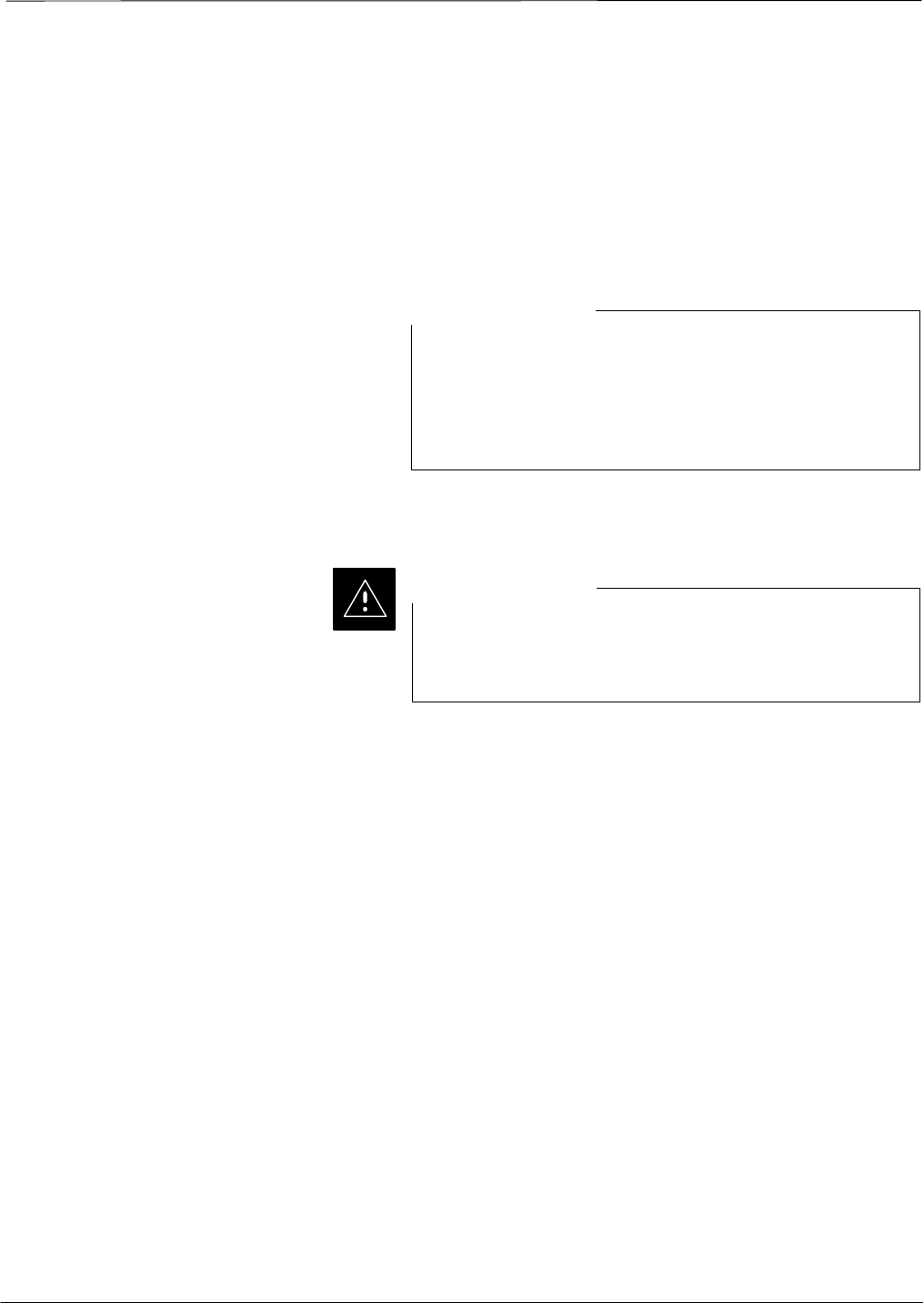
FCC Part 15
DRAFT
SCt4812ET BTS Optimization/ATP — CDMA LMF Apr 2001
xii
FCC Part 15 Requirements
This section conveys FCC Part 15 requirements for the T/ET/ETL series
BTS cabinets.
Part 15.19a(3) – INFORMATION TO USER
This device complies with Part 15 of the FCC Rules.
Operation is subject to the following two conditions:
(1) this device may not cause harmful interference, and
(2) this device must accept any interference received,
including interference that may cause undesired operation.
NOTE
Part 15.21 – INFORMATION TO USER
Changes or modifications not expressly approved by
Motorola could void your authority to operate the
equipment.
CAUTION

FCC Part 15 – continued
Apr 2001 xiii
SCt4812ET BTS Optimization/ATP — CDMA LMF
DRAFT
15.105(b) – INFORMATION TO USER
This equipment has been tested and found to comply with
the limits for a Class B digital device, pursuant to Part 15
of the FCC Rules. These limits are designed to provide
reasonable protection against harmful interference in a
residential installation. This equipment generates, uses and
can radiate radio frequency energy and, if not installed and
used in accordance with the instructions, may cause
harmful interference to radio communications. However,
there is no guarantee that interference will not occur in a
particular installation. If this equipment does cause harmful
interference to radio or television reception, which can be
determined by turning the equipment OFF and ON, the
user is encouraged to try to correct the interference by one
or more of the following measures:
–Reorient or relocate the receiving antenna.
–Increase the separation between the equipment and re-
ceiver.
–Connect the equipment into an outlet on a circuit differ-
ent from that to which the receiver is connected.
–Consult the dealer or an experienced radio/TV technician
for help.
NOTE

FCC Part 68
DRAFT
SCt4812ET BTS Optimization/ATP — CDMA LMF Apr 2001
xiv
FCC Part 68 Requirements
This equipment complies with Part 68 of the Federal Communications
Commission (FCC) Rules and regulations. A label inside the cabinet
frame easily visible with the door open in the upper portion of the
cabinet contains, among other information, the FCC Registration
Number and Ringer Equivalence Number (REN) for this equipment. If
requested, this information must be provided to the telephone company.
The REN is useful to determine the quantity of the devices which may
connect to the telephone line. Excessive RENs on the telephone line may
result in the devices not ringing in response to incoming calls. In most,
but not all areas, the sum of the RENs should not exceed five (5.0). To
be certain of the number of devices that may be connected to the line as
determined by the total RENs, contact the telephone company to
determine the maximum REN for the calling area.
If the dial–in site access modem causes harm to the telephone network,
the telephone company will notify you in advance that temporary
discontinuance of service may be required. If advance notice is not
practical, the telephone company will notify you of the discontinuance as
soon as possible. Also, you will be advised of your right to file a
complaint with the FCC if you believe it is necessary.
The telephone company may make changes in its facilities, equipment,
operations, or procedures that could affect the operation of your dial–in
site access modem. If this happens, the telephone company will provide
advance notice so that you can modify your equipment as required to
maintain uninterrupted service.
If you experience trouble with the dial–in site access modem, please
contact:
Motorola Cellular Service Center (MCSC)
1501 W. Shure Drive
Arlington Heights, Illinois 60004
Phone Number: (847) 632–5390
for repair and/or warranty information. If the trouble is causing harm to
the telephone network, the telephone company may request you to
disconnect the equipment from the network until the problem is solved.
You should not attempt to repair this equipment yourself. This
equipment contains no customer or user–serviceable parts.
Changes or modifications not expressly approved by Motorola could
void your authority to operate this equipment.
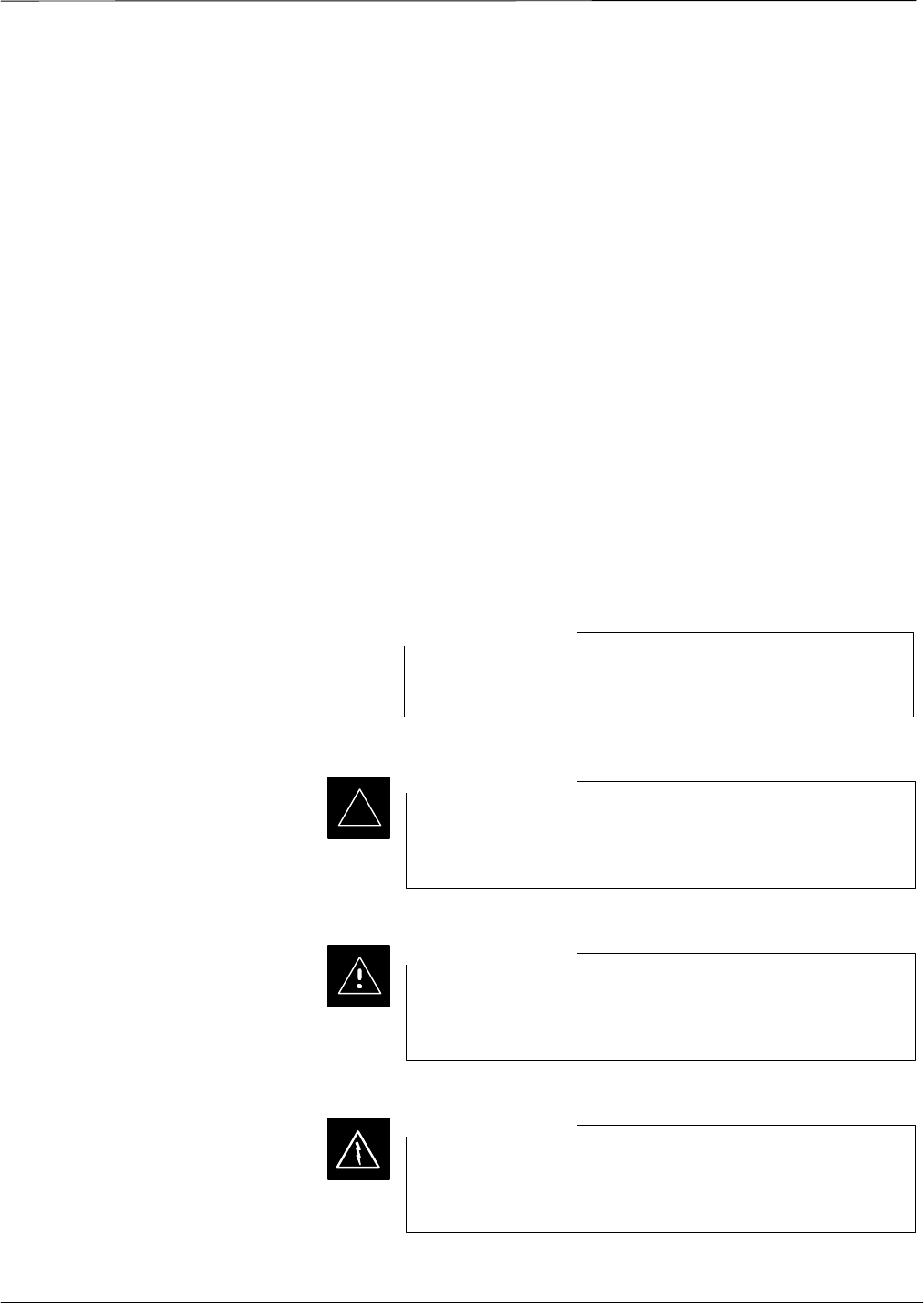
Foreword
Apr 2001 xv
SCt4812ET BTS Optimization/ATP — CDMA LMF
DRAFT
Scope of manual
This manual is intended for use by cellular telephone system
craftspersons in the day-to-day operation of Motorola cellular system
equipment and ancillary devices. It is assumed that the user of this
information has a general understanding of telephony, as used in the
operation of the Public Switched Telephone Network (PSTN), and is
familiar with these concepts as they are applied in the cellular
mobile/portable radiotelephone environment. The user, however, is not
expected to have any detailed technical knowledge of the internal
operation of the equipment.
This manual is not intended to replace the system and equipment
training offered by Motorola, although it can be used to supplement or
enhance the knowledge gained through such training.
Text conventions
The following special paragraphs are used in this manual to point out
information that must be read. This information may be set-off from the
surrounding text, but is always preceded by a bold title in capital letters.
The four categories of these special paragraphs are:
Presents additional, helpful, non-critical information that
you can use.
NOTE
Presents information to help you avoid an undesirable
situation or provides additional information to help you
understand a topic or concept.
IMPORTANT
*
Presents information to identify a situation in which
equipment damage could occur, thus avoiding damage to
equipment.
CAUTION
Presents information to warn you of a potentially
hazardous situation in which there is a possibility of
personal injury.
WARNING
. . . continued on next page

Foreword – continued
DRAFT
SCt4812ET BTS Optimization/ATP — CDMA LMF Apr 2001
xvi
The following typographical conventions are used for the presentation of
software information:In text, typewriter style characters represent
prompts and the system output as displayed on a Hyperterminal screen.
Changes to manual
Changes that occur after the printing date are incorporated into your
manual by Cellular Manual Revisions (CMRs). The information in this
manual is updated, as required, by a CMR when new options and
procedures become available for general use or when engineering
changes occur. The cover sheet(s) that accompany each CMR should be
retained for future reference. Refer to the Revision History page for a list
of all applicable CMRs contained in this manual.
Receiving updates
Technical Education & Documentation (TED) maintains a customer
database that reflects the type and number of manuals ordered or shipped
since the original delivery of your Motorola equipment. Also identified
in this database is a “key” individual (such as Documentation
Coordinator or Facility Librarian) designated to receive manual updates
from TED as they are released.
To ensure that your facility receives updates to your manuals, it is
important that the information in our database is correct and up-to-date.
Therefore, if you have corrections or wish to make changes to the
information in our database (i.e., to assign a new “key” individual),
please contact Technical Education & Documentation at:
MOTOROLA, INC.
Technical Education & Documentation
1 Nelson C. White Parkway
Mundelein, Illinois 60060
U.S.A.
Phone:
Within U.S.A. and Canada 800-872-8225. . . . .
Outside of U.S.A. and Canada +1-847-435–5700. .
FAX: +1-847-435–5541. . . . . . . . . . . . . . . . . . . . . .
Reporting manual errors
In the event that you locate an error or identify a deficiency in your
manual, please take time to write to us at the address above. Be sure to
include your name and address, the complete manual title and part
number (located on the manual spine, cover, or title page), the page
number (found at the bottom of each page) where the error is located,
and any comments you may have regarding what you have found. We
appreciate any comments from the users of our manuals.

Foreword – continued
Apr 2001 xvii
SCt4812ET BTS Optimization/ATP — CDMA LMF
DRAFT
24-hour support service
If you have any questions or concerns regarding the operation of your
equipment, please contact the Customer Network Resolution Center for
immediate assistance. The 24 hour telephone numbers are:
Arlington Heights, IL 800–433–5202. . . . . . . . .
Arlington Heights, International +1–847–632–5390.
Cork, Ireland 44–1793–565444. . . . . . . . . . . . . . . .
Swindon, England 44–1793–565444. . . . . . . . . . . . .
Material Available from
Motorola Infrastructure Group
Worldwide Cellular Services
Material available from Motorola Infrastructure Group Worldwide
Cellular Services, identified by a Motorola part number can be ordered
from your sales account manager or by calling (800) 453–7988.

General Safety
DRAFT
SCt4812ET BTS Optimization/ATP — CDMA LMF Apr 2001
xviii
Remember! . . . Safety
depends on you!!
The following general safety precautions must be observed during all
phases of operation, service, and repair of the equipment described in
this manual. Failure to comply with these precautions or with specific
warnings elsewhere in this manual violates safety standards of design,
manufacture, and intended use of the equipment. Motorola, Inc. assumes
no liability for the customer’s failure to comply with these requirements.
The safety precautions listed below represent warnings of certain dangers
of which we are aware. You, as the user of this product, should follow
these warnings and all other safety precautions necessary for the safe
operation of the equipment in your operating environment.
Ground the instrument
To minimize shock hazard, the equipment chassis and enclosure must be
connected to an electrical ground. If the equipment is supplied with a
three-conductor ac power cable, the power cable must be either plugged
into an approved three-contact electrical outlet or used with a
three-contact to two-contact adapter. The three-contact to two-contact
adapter must have the grounding wire (green) firmly connected to an
electrical ground (safety ground) at the power outlet. The power jack and
mating plug of the power cable must meet International Electrotechnical
Commission (IEC) safety standards.
Do not operate in an explosive
atmosphere
Do not operate the equipment in the presence of flammable gases or
fumes. Operation of any electrical equipment in such an environment
constitutes a definite safety hazard.
Keep away from live circuits
Operating personnel must:
Snot remove equipment covers. Only Factory Authorized Service
Personnel or other qualified maintenance personnel may remove
equipment covers for internal subassembly, or component
replacement, or any internal adjustment.
Snot replace components with power cable connected. Under certain
conditions, dangerous voltages may exist even with the power cable
removed.
Salways disconnect power and discharge circuits before touching them.
Do not service or adjust alone
Do not attempt internal service or adjustment, unless another person,
capable of rendering first aid and resuscitation, is present.
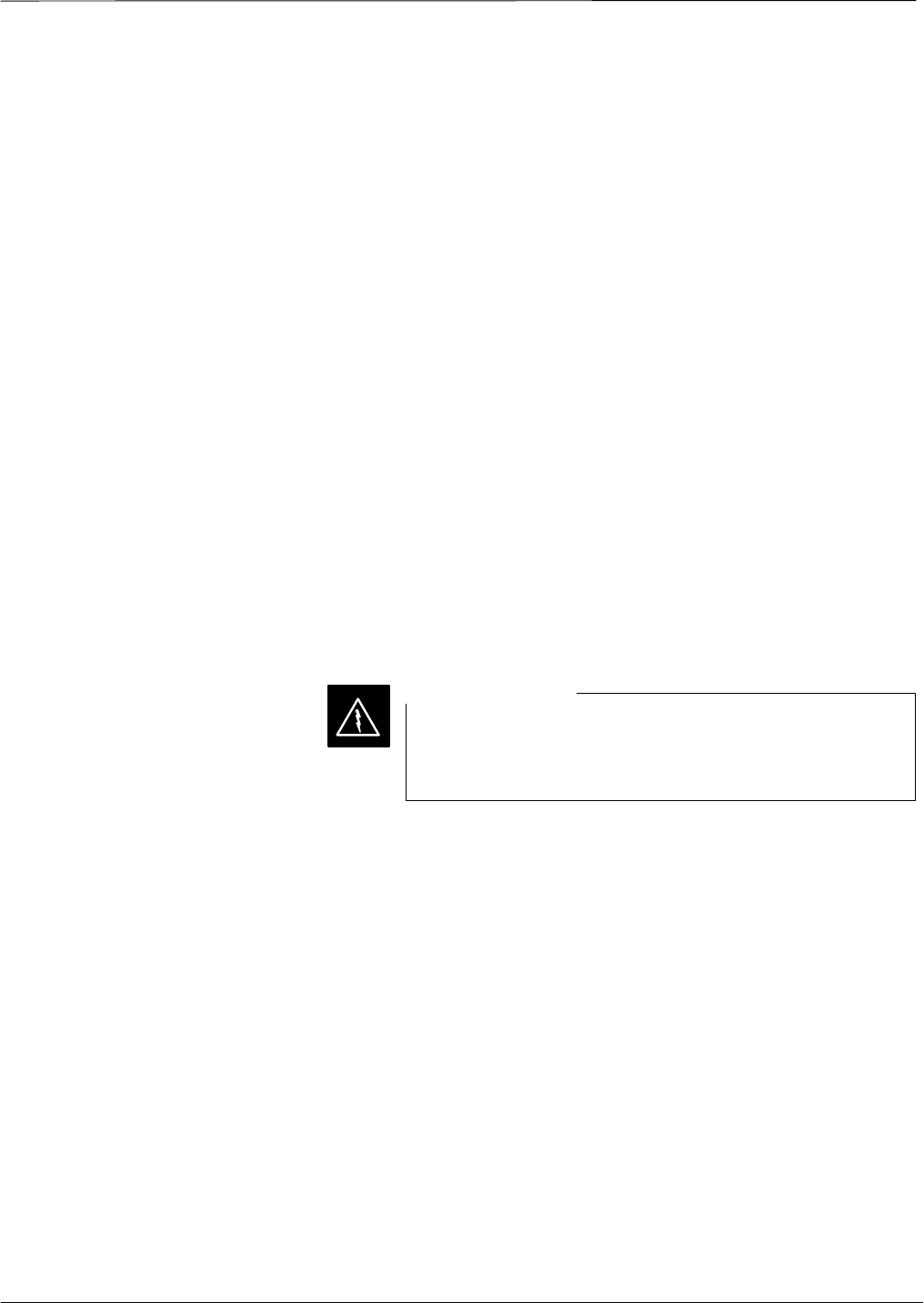
General Safety – continued
Apr 2001 xix
SCt4812ET BTS Optimization/ATP — CDMA LMF
DRAFT
Use caution when exposing or
handling the CRT
Breakage of the Cathode–Ray Tube (CRT) causes a high-velocity
scattering of glass fragments (implosion). To prevent CRT implosion,
avoid rough handling or jarring of the equipment. The CRT should be
handled only by qualified maintenance personnel, using approved safety
mask and gloves.
Do not substitute parts or
modify equipment
Because of the danger of introducing additional hazards, do not install
substitute parts or perform any unauthorized modification of equipment.
Contact Motorola Warranty and Repair for service and repair to ensure
that safety features are maintained.
Dangerous procedure
warnings
Warnings, such as the example below, precede potentially dangerous
procedures throughout this manual. Instructions contained in the
warnings must be followed. You should also employ all other safety
precautions that you deem necessary for the operation of the equipment
in your operating environment.
Dangerous voltages, capable of causing death, are present in this
equipment. Use extreme caution when handling, testing, and
adjusting.
WARNING

Revision History
DRAFT
SCt4812ET BTS Optimization/ATP — CDMA LMF Apr 2001
xx
Manual Number
68P09253A74–1
Manual Title
SCt4812ET BTS Optimization/ATP — CDMA LMF
CDMA 1.9 GHz and 800 MHz
Version Information
The following table lists the manual version , date of version, and
remarks on the version.
Version
Level Date of
Issue Remarks
1April 2001 Preliminary DRAFT of document

Patent Notification
Apr 2001 xxi
SCt4812ET BTS Optimization/ATP — CDMA LMF
DRAFT
Patent numbers
This product is manufactured and/or operated under one or more of the
following patents and other patents pending:
4128740 4661790 4860281 5036515 5119508 5204876 5247544 5301353
4193036 4667172 4866710 5036531 5121414 5204977 5251233 5301365
4237534 4672657 4870686 5038399 5123014 5207491 5255292 5303240
4268722 4694484 4872204 5040127 5127040 5210771 5257398 5303289
4282493 4696027 4873683 5041699 5127100 5212815 5259021 5303407
4301531 4704734 4876740 5047762 5128959 5212826 5261119 5305468
4302845 4709344 4881082 5048116 5130663 5214675 5263047 5307022
4312074 4710724 4885553 5055800 5133010 5214774 5263052 5307512
4350958 4726050 4887050 5055802 5140286 5216692 5263055 5309443
4354248 4729531 4887265 5058136 5142551 5218630 5265122 5309503
4367443 4737978 4893327 5060227 5142696 5220936 5268933 5311143
4369516 4742514 4896361 5060265 5144644 5222078 5271042 5311176
4369520 4751725 4910470 5065408 5146609 5222123 5274844 5311571
4369522 4754450 4914696 5067139 5146610 5222141 5274845 5313489
4375622 4764737 4918732 5068625 5152007 5222251 5276685 5319712
4485486 4764849 4941203 5070310 5155448 5224121 5276707 5321705
4491972 4775998 4945570 5073909 5157693 5224122 5276906 5321737
4517561 4775999 4956854 5073971 5159283 5226058 5276907 5323391
4519096 4797947 4970475 5075651 5159593 5228029 5276911 5325394
4549311 4799253 4972355 5077532 5159608 5230007 5276913 5327575
4550426 4802236 4972432 5077741 5170392 5233633 5276915 5329547
4564821 4803726 4979207 5077757 5170485 5235612 5278871 5329635
4573017 4811377 4984219 5081641 5170492 5235614 5280630 5339337
4581602 4811380 4984290 5083304 5182749 5239294 5285447 D337328
4590473 4811404 4992753 5090051 5184349 5239675 5287544 D342249
4591851 4817157 4998289 5093632 5185739 5241545 5287556 D342250
4616314 4827507 5020076 5095500 5187809 5241548 5289505 D347004
4636791 4829543 5021801 5105435 5187811 5241650 5291475 D349689
4644351 4833701 5022054 5111454 5193102 5241688 5295136 RE31814
4646038 4837800 5023900 5111478 5195108 5243653 5297161
4649543 4843633 5028885 5113400 5200655 5245611 5299228
4654655 4847869 5030793 5117441 5203010 5245629 5301056
4654867 4852090 5031193 5119040 5204874 5245634 5301188

Patent Notification – continued
DRAFT
SCt4812ET BTS Optimization/ATP — CDMA LMF Apr 2001
xxii
Notes

Apr 2001 SCt4812ET BTS Optimization/ATP — CDMA LMF
DRAFT
Chapter 1: Introduction
Table of Contents
Optimization Overview 1-1. . . . . . . . . . . . . . . . . . . . . . . . . . . . . . . . . . . . . . . . . . . .
Scope of This Document 1-1. . . . . . . . . . . . . . . . . . . . . . . . . . . . . . . . . . . .
Document Composition 1-1. . . . . . . . . . . . . . . . . . . . . . . . . . . . . . . . . . . . .
CDMA LMF Product Description 1-2. . . . . . . . . . . . . . . . . . . . . . . . . . . . .
Online Help 1-2. . . . . . . . . . . . . . . . . . . . . . . . . . . . . . . . . . . . . . . . . . . . . .
Why Optimize? 1-2. . . . . . . . . . . . . . . . . . . . . . . . . . . . . . . . . . . . . . . . . . .
What Is Optimization? 1-2. . . . . . . . . . . . . . . . . . . . . . . . . . . . . . . . . . . . . .
When to Optimize 1-3. . . . . . . . . . . . . . . . . . . . . . . . . . . . . . . . . . . . . . . . .
Required Documents 1-4. . . . . . . . . . . . . . . . . . . . . . . . . . . . . . . . . . . . . . .
Additional Information 1-4. . . . . . . . . . . . . . . . . . . . . . . . . . . . . . . . . . . . .
Test Equipment Overview 1-4. . . . . . . . . . . . . . . . . . . . . . . . . . . . . . . . . . .
LMF Hardware Requirements 1-5. . . . . . . . . . . . . . . . . . . . . . . . . . . . . . . .
Required Test Equipment 1-6. . . . . . . . . . . . . . . . . . . . . . . . . . . . . . . . . . .
Test Equipment Calibration 1-6. . . . . . . . . . . . . . . . . . . . . . . . . . . . . . . . . .
Test Cable Calibration 1-6. . . . . . . . . . . . . . . . . . . . . . . . . . . . . . . . . . . . . .
Equipment Warm–up 1-6. . . . . . . . . . . . . . . . . . . . . . . . . . . . . . . . . . . . . . .
Test Equipment List 1-7. . . . . . . . . . . . . . . . . . . . . . . . . . . . . . . . . . . . . . . .
Optional Equipment 1-10. . . . . . . . . . . . . . . . . . . . . . . . . . . . . . . . . . . . . . . .
Abbreviations and Acronyms 1-11. . . . . . . . . . . . . . . . . . . . . . . . . . . . . . . .
BTS Equipment Identification 1-13. . . . . . . . . . . . . . . . . . . . . . . . . . . . . . . . . . . . . .
Equipment Overview 1-13. . . . . . . . . . . . . . . . . . . . . . . . . . . . . . . . . . . . . . .
Logical BTS 1-13. . . . . . . . . . . . . . . . . . . . . . . . . . . . . . . . . . . . . . . . . . . . . .
Major Components 1-16. . . . . . . . . . . . . . . . . . . . . . . . . . . . . . . . . . . . . . . .
RF Cabinet Internal FRUs 1-17. . . . . . . . . . . . . . . . . . . . . . . . . . . . . . . . . . .
Sector Configuration 1-23. . . . . . . . . . . . . . . . . . . . . . . . . . . . . . . . . . . . . . .
Power Cabinet 1-26. . . . . . . . . . . . . . . . . . . . . . . . . . . . . . . . . . . . . . . . . . . .
Power Cabinet Internal FRUs 1-27. . . . . . . . . . . . . . . . . . . . . . . . . . . . . . . .
1

Table of Contents – continued
DRAFT
SCt4812ET BTS Optimization/ATP — CDMA LMF Apr 2001
Notes
1

Optimization Overview
Apr 2001 1-1
SCt4812ET BTS Optimization/ATP — CDMA LMF
DRAFT
Scope of This Document
This document provides information pertaining to the optimization and
audit tests of Motorola SC 4812ET Base Transceiver Subsystem (BTS)
equipment frames equipped with trunked high–power Linear Power
Amplifiers (LPAs) and their associated internal and external interfaces.
This document assumes the following prerequisites: The BTS frames
and cabling have been installed per the BTS Hardware Installation Manual
– 68P64114A22, which covers the physical “bolt down” of all SC series
equipment frames, and the specific cabling configurations.
Document Composition
This document covers the following major areas:
SIntroduction, consisting of preliminary background information (such
as component and subassembly locations and frame layouts) to be
considered by the Cell Site Field Engineer (CFE) before optimization
or tests are performed.
SPreliminary Operations, consisting of cabinet power up and power
down procedures.
SOptimization/calibration, covering topics of Local Maintenance
Facility (LMF) connection to the BTS equipment, Global Positioning
System (GPS) Verification, test equipment setup, downloading all
BTS processor boards, RF path verification, Bay Level Offset (BLO)
calibration and calibration audit, and Radio Frequency Diagnostic
System (RFDS) calibration.
SAcceptance Test Procedures (ATPs), consisting of ATP tests executed
by the LMF and used to verify all major transmit (TX) and
receive (RX) performance characteristics on all BTS equipment.
SPreparing to leave the site, presents instructions on how to properly
exit customer site, ensure that all equipment is operating properly, and
all work is complete according to Motorola guidelines.
SBasic troubleshooting, consisting of procedures for installation,
calibration, transmit and receive tests, backplane problems, GPS
failures, and module connectors.
SAppendices contain pertinent Pseudorandom Noise (PN) Offset,
frequency programming, output power data tables, data sheets that are
filled out manually by the CFE at the site, and information on test
equipment preparation.
1

Optimization Overview – continued
DRAFT
SCt4812ET BTS Optimization/ATP — CDMA LMF Apr 2001
1-2
CDMA LMF Product Description
The Code Division Multiple Access (CDMA) LMF is a graphical user
interface (GUI) based LMF. This product is specifically designed to
provide cellular communications field personnel the vehicle to support
the following CDMA BTS operations:
SInstallation
SMaintenance
SCalibration
SOptimization
The LMF also provides Command Line Interface (CLI) capability.
Activate the CLI by clicking on a shortcut icon on the desktop. The CLI
cannot be launched from the GUI, only from the desktop icon.
Online Help
Task oriented online help is available in the LMF by clicking on Help
from the menu bar.
Why Optimize?
Proper optimization and calibration assures:
SAccurate downlink RF power levels are transmitted from the site.
SAccurate uplink signal strength determinations are made by the site.
What Is Optimization?
Optimization compensates for the site-specific cabling and normal
equipment variations. Cables that interconnect the BTS and Duplexer
assemblies (if used), for example, are cut and installed at the time of the
BTS frame installation at the site. Site optimization guarantees that the
combined losses of the new cables and the gain/loss characteristics and
built-in tolerances of each BTS frame do not accumulate, causing
improper site operation.
Optimization identifies the accumulated loss (or gain) for all receive and
transmit paths at the BTS site, and stores that value in a database.
SThe RX path starts at the ancillary equipment frame RFDS RX
directional coupler antenna feedline port, through the RX input port
on the rear of the frame, through the DDRCs, Multicoupler Preselector
Card (MPC), and additional splitter circuitry, ending at a CDMA
Channel Processor (C–CCP) backplane Broad Band Transceiver
(BBX) slot in the C–CCP shelf.
SA transmit path starts at the BBX, through the C–CCP backplane slot,
travels through the LPA/Combiner TX Filter and ends at the rear of
the input/output (I/O) Panel. If the RFDS option is added, then the
TX path continues and ends at the top of the RFDS TX directional
coupler antenna feedline port installed in the ancillary equipment
frame.
. . . continued on next page
1

Optimization Overview – continued
Apr 2001 1-3
SCt4812ET BTS Optimization/ATP — CDMA LMF
DRAFT
These values are factored in by the BTS equipment internally, leaving
only site specific antenna feed line loss and antenna gain characteristics
to be factored in by the CFE when determining site Effective Radiated
Power (ERP) output power requirements.
Each C–CCP shelf BBX board is optimized to a specific RX and TX
antenna port. (One BBX board acts in a redundant capacity for BBXs
1–12, and is optimized to all antenna ports). A single value is generated
for each path, thereby eliminating the accumulation of error that would
occur from individually measuring and summing the gain and loss of
each element in the path.
When to Optimize
New Installations
After the initial site installation, the BTS must be prepared for operation.
This preparation includes verifying hardware installation, initial power
up, and GPS verification. Basic alarm tests are also addressed.
A calibration audit of all RF transmit paths is performed to verify factory
calibration.
A series of ATP CDMA verification tests are covered using the actual
equipment set up. An ATP is also required before the site can be placed
in service.
Site Expansion
Optimization is also required after expansion of a site.
Periodic Optimization
Periodic optimization of a site may also be required, depending on the
requirements of the overall system.
Repaired Sites
Verify repair(s) made to the BTS by consulting an Optimization/ATP
Test Matrix table. This table outlines the specific tests that must be
performed anytime a BTS subassembly or RF cable associated with it is
replaced.
Refer to Appendix B for detailed basic guideline tables and
detailed Optimization/ATP Test Matrix.
IMPORTANT
*
1

Optimization Overview – continued
DRAFT
SCt4812ET BTS Optimization/ATP — CDMA LMF Apr 2001
1-4
Required Documents
The following documents are required to perform optimization of the
cell site equipment:
SSite document (generated by Motorola systems engineering), which
includes:
–General site information
–Floor plans
–Power levels
–Site PN
–Site paging and traffic channel allocation
–Board placement
–Site wiring lists
–Cell–site Data Files (CDF)
SDemarcation document (scope of work agreement)
SEquipment manuals for non-Motorola test equipment.
Additional Information
For other information, refer to the following manuals:
SCDMA LMF Operators Guide
Delivered as on-line help with your system
S4812ET Field Replacement Units Guide
(Motorola part number 68P09253A48)
SSC 4812ET RF & Power Cabinet Hardware Installation Manual
(Motorola part number 68P09253A93)
S Logical BTS Implementation
(Motorola part number 68P09253A79)
Test Equipment Overview
The LMF is used in conjunction with Motorola recommended test
equipment, and it is a part of a “calibrated test set.” To ensure consistent,
reliable, and repeatable optimization test results, only recommended test
equipment supported by the LMF must be used to optimize the BTS
equipment. Table 1-1 outlines the supported test equipment that meets the
technical criteria required for BTS optimization.
Table 1-1: CDMA LMF Test Equipment Support Table
Item Description
Hewlett Packard, model
HP 8921A
Cellular communications analyzer
(includes 83203B CDMA interface
option)
Hewlett Packard, model
HP 83236A
PCS interface for PCS band
. . . continued on next page
1
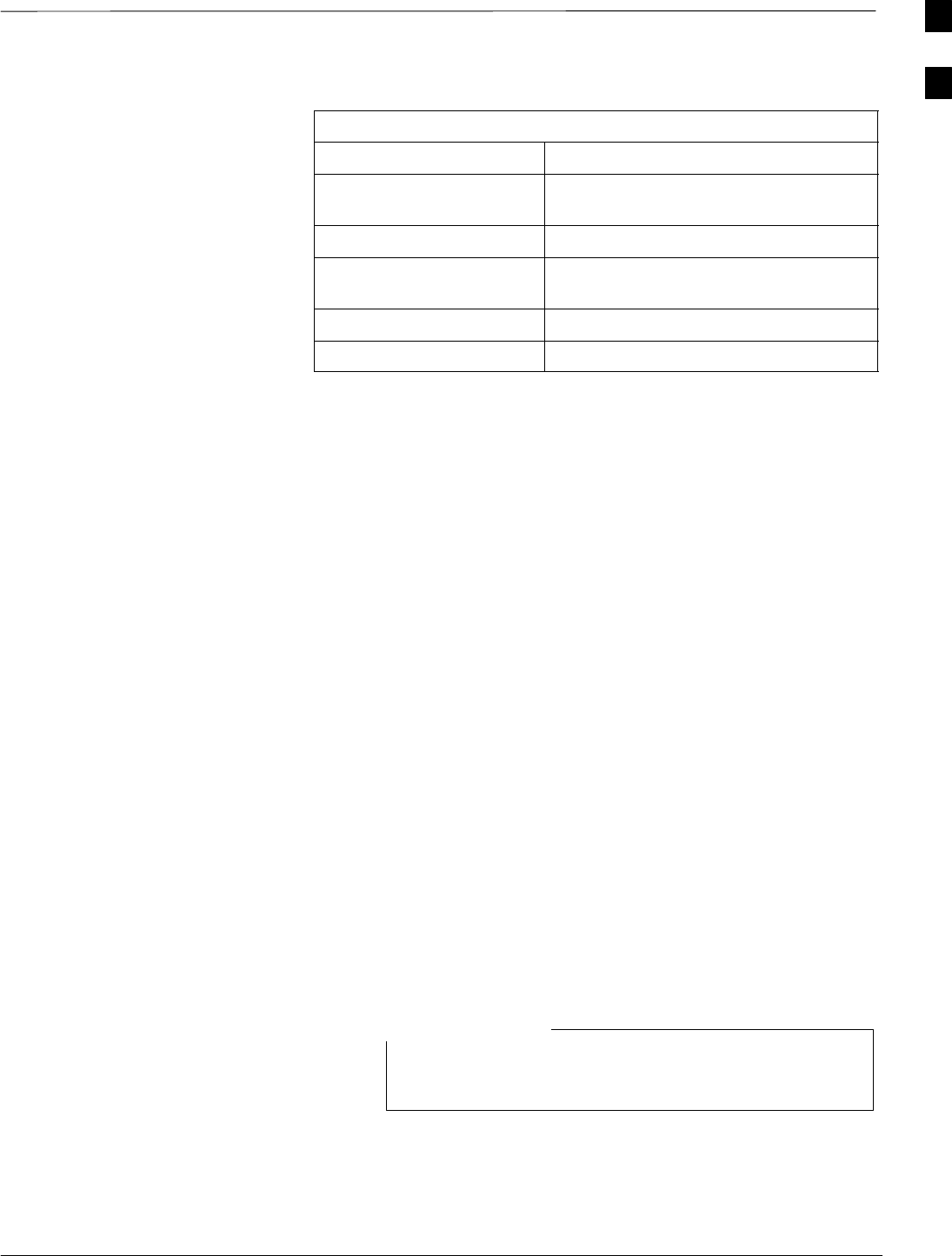
Optimization Overview – continued
Apr 2001 1-5
SCt4812ET BTS Optimization/ATP — CDMA LMF
DRAFT
Table 1-1: CDMA LMF Test Equipment Support Table
Item Description
Hewlett Packard, model
HP 8935 Cellular cmmunications analyzer
Motorola CyberTest Cellular communications analyzer
Advantest R3465 with
3561 CDMA option Cellular communications analyzer
Gigatronix 8541C Power meter
HP437B Power meter
To ensure consistent, reliable, and repeatable optimization test results,
test equipment meeting the following technical criteria should be used to
optimize the BTS equipment. You can, of course, substitute test
equipment with other test equipment models supported by the LMF
meeting the same technical specifications.
LMF Hardware Requirements
An LMF computer platform that meets the following requirements (or
better) is recommended:
SNotebook computer
S266 MHz (32 bit CPU) Pentium processor
S4 Gbyte internal hard disk drive
SColor display with 1024 x 768 (recommended) or 800 x 600 pixel
resolution
S64 MB RAM
SCD ROM drive
S3 1/2 inch floppy drive
SSerial port (COM 1)
SParallel port (LPT 1)
SPCMCIA Ethernet interface card (for example, 3COM Etherlink III)
with a 10Base–T–to–coax adapter
SWindows 98/NT operating system
If 800 x 600 pixel resolution is used, the LMF window
must be maximized after it is displayed.
NOTE
1

Optimization Overview – continued
DRAFT
SCt4812ET BTS Optimization/ATP — CDMA LMF Apr 2001
1-6
Required Test Equipment
To ensure consistent, reliable, and repeatable optimization test results,
test equipment meeting the following technical criteria should be used to
optimize the BTS equipment. You can, of course, substitute test
equipment with other test equipment models supported by the LMF
meeting the same technical specifications.
During manual testing, you can substitute test equipment
with other test equipment models not supported by the
LMF, but those models must meet the same technical
specifications.
NOTE
The customer has the responsibility of accounting for any measurement
variances and/or additional losses/inaccuracies that can be introduced
as a result of these substitutions. Before beginning optimization or
troubleshooting, make sure that the test equipment needed is on hand
and operating properly.
Test Equipment Calibration
Optimum system performance and capacity depend on regular equipment
service, calibration, and characterization prior to BTS optimization.
Follow the original equipment manufacturer (OEM) recommended
maintenance and calibration schedules closely.
Test Cable Calibration
Equipment test cables are very important in optimization. Motorola
recommends that the cable calibration be run at every BTS with the test
cables attached. This method compensates for test cable insertion loss
within the test equipment itself. No other allowance for test cable
insertion loss needs to be made during the performance of tests.
Another method is to account for the loss by entering it into the LMF
during the optimization procedure. This method requires accurate test
cable characterization in a shop. The cable should be tagged with the
characterization information prior to field optimization.
Equipment Warm–up
After arriving at the a site, the test equipment should be plugged in and
turned on to allow warm up and stabilization to occur for as long as
possible. The following pieces of test equipment must be warmed–up for
a minimum of 60 minutes prior to using for BTS optimization or RFDS
calibration procedures.
SCommunications test set
SRubidium time base
SPower meter
1

Optimization Overview – continued
Apr 2001 1-7
SCt4812ET BTS Optimization/ATP — CDMA LMF
DRAFT
Test Equipment List
The following pieces of test equipment are required during the
optimization procedure. Common assorted tools like screwdrivers and
frame keys are not listed but are still required. Read the owner’s manual
on all of the following major pieces of test equipment to understand their
individual operation prior to use in optimization.
Always refer to specific OEM test equipment
documentation for detailed operating instructions.
NOTE
10BaseT/10Base2 Converter
Ethernet LAN transceiver (part of CGDSLMFCPQ1700)
SPCMCIA Ethernet Adpater + Ethernet UTP adapter: 3COM model –
Etherlink III 3C589B
Transition Engineering model E–CX–TBT–03 10BaseT/10Base2
converter
Xircom model PE3–10B2 or equivalent can also be used to
interface the LMF Ethernet connection to the frame.
NOTE
RS–232 to GPIB Interface
SNational Instruments GPIB–232–CT with Motorola CGDSEDN04X
RS232 serial null modem cable (see Figure 1-1) or equivalent; used to
interface the LMF to the test equipment.
SStandard RS–232 cable can be used with the following modifications:
–This solution passes only the 3 minimum electrical connections
between the LMF and the GPIB interface. The control signals are
jumpered as enabled on both ends of the RS–232 cable (9–pin D).
TX and RX signals are crossed as null modem effect. Pin 5 is the
ground reference.
–Short pins 7 and 8 together, and short pins 1, 4, and 6 together on
each connector.
Figure 1-1: Null Modem Cable Detail
5
3
2
7
8
1
4
6
GND
RX
TX
RTS
CTS
RSD/DCD
DTR
GND
TX
RX
RTS
CTS
RSD/DCD
DTR
ON BOTH CONNECTORS
SHORT PINS 7, 8;
SHORT PINS 1, 4, & 6
9–PIN D–FEMALE 9–PIN D–FEMALE
5
2
3
7
8
1
4
6
DSR DSR
FW00362
1

Optimization Overview – continued
DRAFT
SCt4812ET BTS Optimization/ATP — CDMA LMF Apr 2001
1-8
Model SLN2006A MMI Interface Kit
SMotorola Model TRN9666A null modem board. Connectors on
opposite sides of the board must be used as this performs a null
modem transformation between cables. This board can used for
10–pin to 8–pin, 25–pin to 25–pin and 10–pin to 10–pin conversions.
SMotorola 30–09786R01 MMI cable or equivalent ; used to interface
the LMF serial port connection to GLI2, CSM and LPA debug serial
ports.
S25 pin D to 25 pin D serial cable from PC to null modem board.
Communications System Analyzer
The communication system analyzer is used during optimization and
testing of the RF communications portion of BTS equipment and
provides the following functions:
(1) Frequency counter
(2) RF power meter (average and code domain)
(3) RF Signal generator (capable of CDMA modulation)
(4) Spectrum analyzer
(5) CDMA code domain analyzer
Four types of communication system analyzers are currently supported
by the LMF:
HP8921A/600 Analyzer – Including 83203B CDMA Interface,
manual control system card, and 83236A/B PCS Interface for 1900 MHz
BTSs.
Advantest R3465 Analyzer – Including R3561L test source unit
HP8935 Analyzer
CyberTest Communication Analyzer
GPIB Cables
SHewlett Packard 10833A or equivalent; 1 to 2 meters (3 to 6 feet) long
used to interconnect test equipment and LMF terminal.
Power Meter
One of the following power meters is required for TX calibration and
audit if an HP8921A or Advantest R3465 analyzer is used:
SHewlett Packard Model HP HP437B with HP8481A power sensor
SGigatronix model 8541C with model 80601A power sensor
Timing Reference Cables
STwo BNC–male to BNC–male RG316 cables; 3 meters (10 ft.) long,
used to interconnect the HP8921A/600 or Advantest R3465
communications analyzer to the CSM front panel timing references in
the BTS.
1

Optimization Overview – continued
Apr 2001 1-9
SCt4812ET BTS Optimization/ATP — CDMA LMF
DRAFT
Two Huber & Suhner 16MCX/11BNC/K02252D or
equivalent; right angle MCX–male to standard BNC–male
RG316 cables; 10 ft. long are required to interconnect the
HP8921A/600 communications analyzer to SGLN4132A
and SGLN1145A CSM board timing references.
NOTE
SBNC “T” adapter with 50 ohm termination.
This BNC “T” adapter (with 50 ohm termination) is
required to connect between the HP 8921A/600 (or
Advantest R3465) EVEN SECOND/SYNC IN and the
BNC cable. The BNC cable leads to the 2–second clock
connection on the TIB. Erroneous test results may occur if
the “T” adapter with the 50 ohm termination is not
connected.
NOTE
Digital Multimeter
SFluke model 8062A with Y8134 test lead kit or equivalent; used for
precision DC and AC measurements, requiring 4–1/2 digits.
Directional Coupler
SNarda model 30661 30 dB (Motorola part no. 58D09732W01) coupler
terminated with two Narda Model 375BN–M loads, or equivalent.
RF Attenuators
S20 dB fixed attenuators, 20 W (Narda 768–20); used with test cable
calibrations or during general troubleshooting procedures.
SNarda Model 30445 30 dB (Motorola Part No. 58D09643T01) coupler
terminated with two Narda Model 375BN–M loads, or equivalent.
Miscellaneous RF Adapters, Loads, etc
SAs required to interface test cables and BTS equipment and for
various test set ups. Should include at least two 50 Ohm loads (type
N) for calibration and one RF short, two N–type female–to–female
adapters.
High–impedance Conductive Wrist Strap
SMotorola model 42–80385A59; used to prevent damage from
Electrostatic Discharge (ESD) when handling or working with
modules.
RF Load (at least three for trunked cabinets)
S100 W non–radiating RF load; used (as required) to provide dummy
RF loading during BTS transmit tests.
1

Optimization Overview – continued
DRAFT
SCt4812ET BTS Optimization/ATP — CDMA LMF Apr 2001
1-10
RF Network Box (and calibrated cables)
SMotorola model SGLN5531A 18:3 Passive Antenna Interface used to
interface test equipment to the BTS receive and transmit antenna
inputs during optimization/ATP or general troubleshooting
procedures.
Optional Equipment
Frequency Counter
SStanford Research Systems SR620 or equivalent. If direct
measurement of the 3 MHz or 19.6608 MHz references is required.
Spectrum Analyzer
SSpectrum Analyzer (HP8594E with CDMA personality card) or
equivalent; required for tests other than standard Receive band spectral
purity and TX LPA IM reduction verification tests performed by the
LMF.
Local Area Network (LAN) Tester
SModel NETcat 800 LAN troubleshooter (or equivalent); used to
supplement LAN tests using the ohm meter.
Span Line (T1/E1) Verification Equipment
SAs required for local application
RF Test Cable (if not Provided with Test Equipment)
SMotorola model TKN8231A; used to connect test equipment to the
BTS transmitter output during optimization or during general
troubleshooting procedures.
Oscilloscope
STektronics model 2445 or equivalent; for waveform viewing, timing,
and measurements or during general troubleshooting procedure.
2–way Splitter
SMini–Circuits model ZFSC–2–2500 or equivalent; provide the
diversity receive input to the BTS
High Stability 10 MHz Rubidium Standard
SStanford Research Systems SR625 or equivalent. Required for CSM
and Low Frequency Receiver/High Stability Oscillator (LFR/HSO)
frequency verification.
1
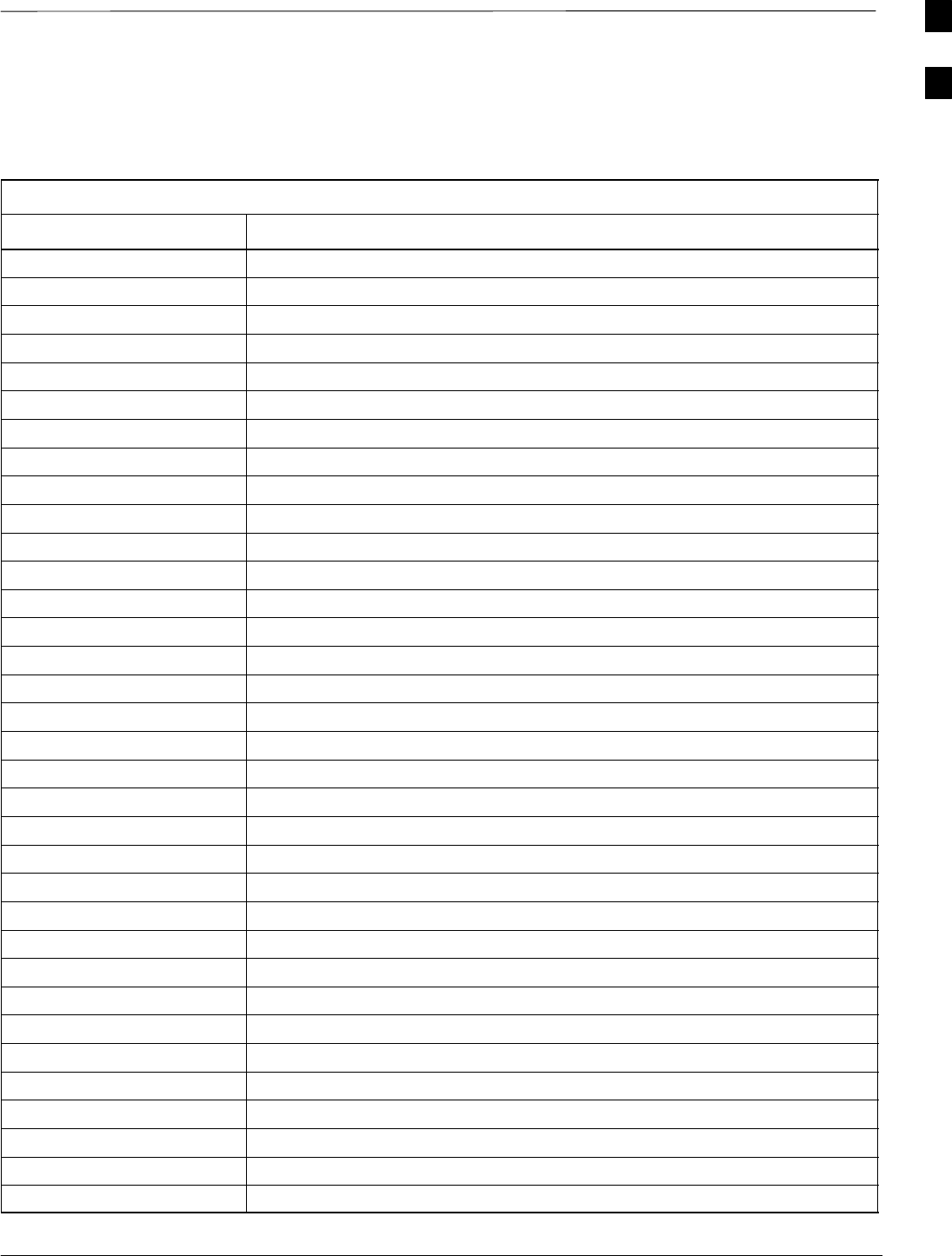
Optimization Overview – continued
Apr 2001 1-11
SCt4812ET BTS Optimization/ATP — CDMA LMF
DRAFT
Abbreviations and
Acronyms
Table 1-2: Abbreviations and Acronyms
Acronym Definition
AMR Alarm Monitor Reporting
ATP Acceptance Test Plan
BBX2 Broadband Transceiver
BLO Bay Level Offset
BTS Base Transceiver Subsystem
CBSC Centralized Base Station Controller
C–CCP Combined CDMA Channel Processor
CCD CDMA Clock Distribution
CDMA Code Division Multiple Access
CE Channel Element
CHI Concentration Highway Interface
CLI Command Line Interface
CIO Combiner Input/Output
CM Channel Module
CMR Cellular Manual Revision
CSM Clock Synchronization Manager
CSU Clock Synchronization Unit
DBPF Dual Bandpass Filter
DBM Debug Monitor
DMAC Digital Metering and Alarm Control (also see MAP)
DRDC Duplexer/RX Filter/Directional Coupler
DSP Digital Signal Processor
EMPC Expansion Multicoupler Preselector Card
FRU Field Replaceable Unit
FSI Frame Status Indicator
GLI 2 Group Line Interface II
GPS Global Positioning System
HSO High Stability Oscillator
IFM Integrated Frame Modem
I&Q Interphase and Quadrature
ISB InterShelf Bus
LAPD Link Access Protocol “D”
LFR Low Frequency Receiver
LMF Local Maintenance Facility
. . . continued on next page
1
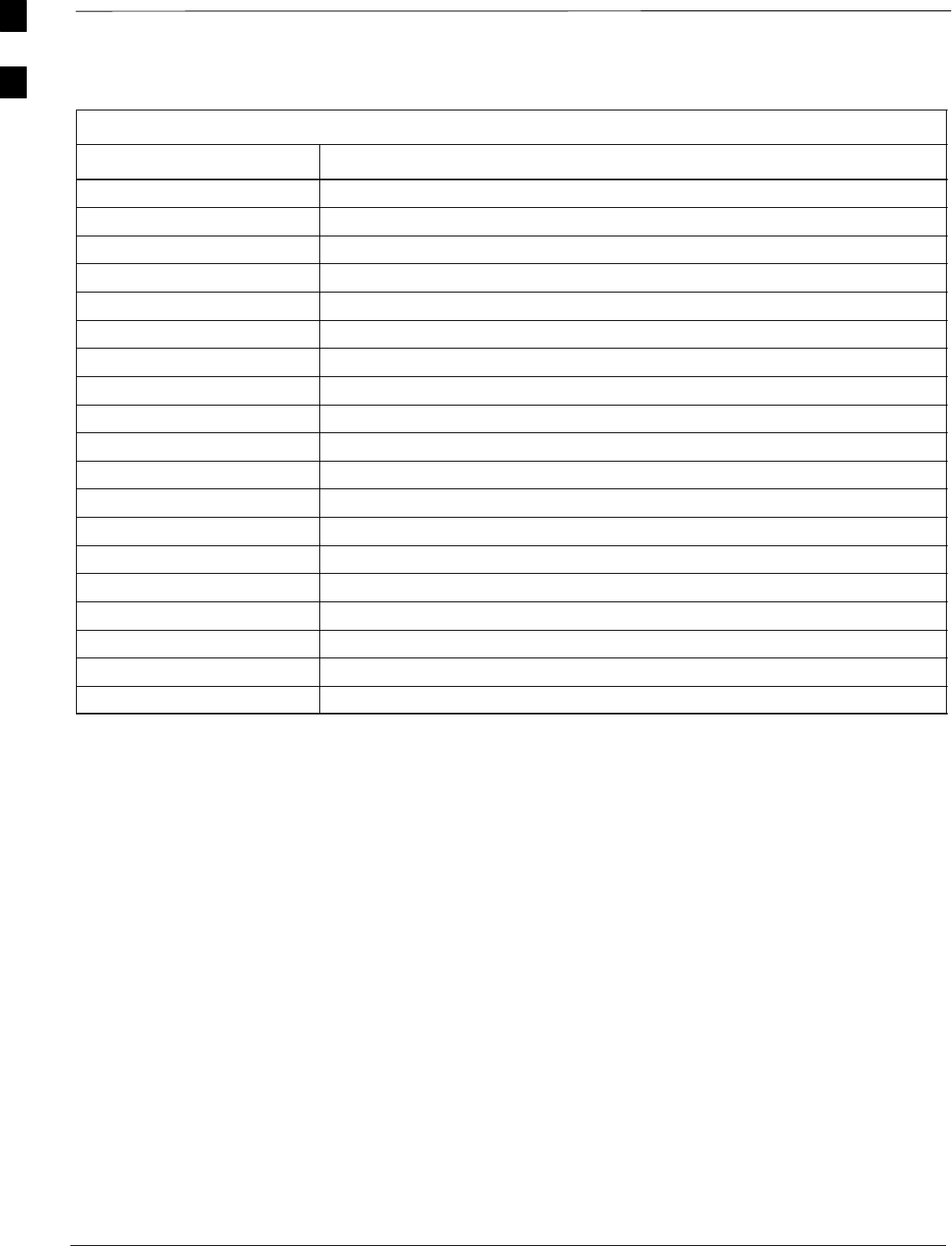
Optimization Overview – continued
DRAFT
SCt4812ET BTS Optimization/ATP — CDMA LMF Apr 2001
1-12
Table 1-2: Abbreviations and Acronyms
Acronym Definition
LORAN LOng RAnge Navigational
LPA Linear Power Amplifier
MAP Meter Alarm Panel (also refered to as DMAC)
MCC Multi–Channel CDMA
MGLI Master Group Line Interface
MM Mobility Manager
MMI Man Machine Interface
MPC Multicoupler Preselector Card
OMCR Operations Maintenance Center – Radio
PCS Personal Communication System
PCSC Personal Communication System Controller
PN Pseudo–random Noise
PSTN Public Switched Telephone Network
QPSK Quadrature Phase Shift Keyed
RFDS Radio Frequency Diagnostic Subsystem
RSSI Received Signal Strength Indicator
SCAP Super Cell Application Protocol
TCH Traffic Channel
TSI Time Slot Interchanger
1

BTS Equipment Identification
Apr 2001 1-13
SCt4812ET BTS Optimization/ATP — CDMA LMF
DRAFT
Equipment Overview
The SC 4812ET BTS consists of an RF Cabinet that is an outdoor,
weatherized version of the SC 4812T. The RF cabinet is powered by
27 Vdc and each cabinet has the capability to support up to 4 carriers (at
3 sector) or 2 carriers (at 6 sector).
The RF Cabinet houses the fan modules, C–CCP, LPA modules, LPA
trunking backplane, Bandpass 2:1 & 4:1 Combiners, Duplexer/Receive
Filter/Directional Couplers (DRDC) and a DC Power distribution
assembly. The Power Cabinet (PC) provides +27 Vdc distribution and
battery backup for the SC 4812ET. The Power Cabinet houses batteries,
battery heaters, rectifiers, an AC Load Center (ACLC), a power
distribution assembly, and two duplexed GFCI convenience outlets.
Logical BTS
A logical BTS can consist of up to four SC 4812ET frames. When the
LMF is connected to frame 1 of a logical BTS, you can access all
devices in all of the frames that make up the logical BTS. A logical BTS
CDF file that includes equippage information for all of the logical BTS
frames and their devices is required. A Centralized Base Station
Controller (CBSC) file that includes channel data for all of the logical
BTS fames is also required.
The first frame of a logical BTS has a –1 suffix (e.g., BTS–812–1) and
other frames of the logical BTS are numbered with suffixes, –101, –201,
and –301 (e. g. BTS–812–201). When you log into a BTS a FRAME
tab is displayed for each frame. If there is only one frame for the BTS,
there will only be one tab (e.g., FRAME–282–1) for BTS–282. If a
logical BTS has more than one frame, there will be a separate FRAME
tab for each frame (e.g. FRAME–438–1, FRAME–438–101, and
FRAME–438–202 for a BTS–438 that has all three frames). If an
RFDS is included in the CDF file, an RFDS tab (e.g., RFDS–438–1)
will be displayed.
Actions (e.g., ATP tests) can be initiated for selected devices in one or
more frames of a logical BTS. Refer to the Select devices help screen
for information on how to select devices.
C–CCP Shelf Card/Module Device ID Numbers
All cards/modules/boards in the frames at a single site, assigned to a
single BTS number, are also identified with unique Device ID numbers
dependent upon the Frame ID number in which they are located. Refer to
Table 1-3 and Table 1-4 for specific C–CCP Shelf Device ID numbers.
1
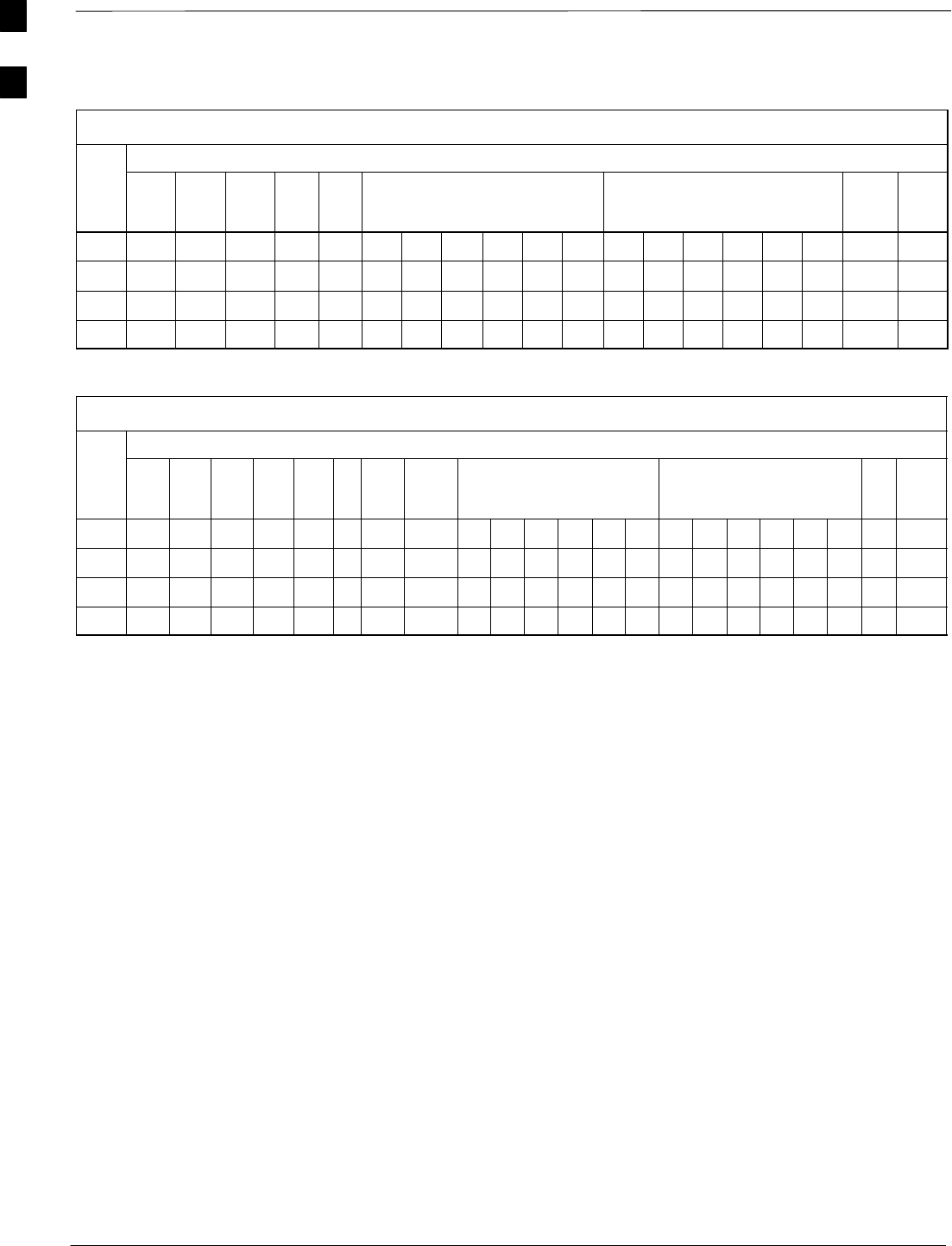
BTS Equipment Identification – continued
DRAFT
SCt4812ET BTS Optimization/ATP — CDMA LMF Apr 2001
1-14
Table 1-3: C–CCP Shelf/Cage Card/Module Device ID Numbers (Top Shelf)
Frame Card/Module ID Number (Left to Right)
#Power
(PS–1) Power
(PS–2) Power
(PS–3) AMR
–1GLI2
–1MCC2 BBX2 BBX2
–RMPC/
EMPC
–1
1–––1 1123456123456 R1 –
101 –––101 101 101 102 103 104 105 106 101 102 103 104 105 106 R101 –
201 –––201 201 201 202 203 204 205 206 201 202 203 204 205 206 R201 –
301 –––301 301 301 302 303 304 305 306 301 302 303 304 305 306 R301 –
Table 1-4: C–CCP Shelf/Cage Card/Module Device ID Numbers (Bottom Shelf)
Frame Card/Module ID Number (Left to Right)
#HSO/
LFR CSM
–1CSM
–2CCD
ACCD
BAMR
–2GLI2–
2MCC2 BBX2 SW MPC/
EMPC
–2
1–1 2 – – – 2 2 7 8 9 10 11 12 7 8 9 10 11 12 – –
101 –101 102 – – – 102 102 107 108 109 110 111 112 107 108 109 110 111 112 – –
201 –201 202 – – – 202 102 207 208 209 210 211 212 207 208 209 210 211 212 – –
301 –301 302 – – – 302 102 307 308 309 310 311 312 307 308 309 310 311 312 – –
1
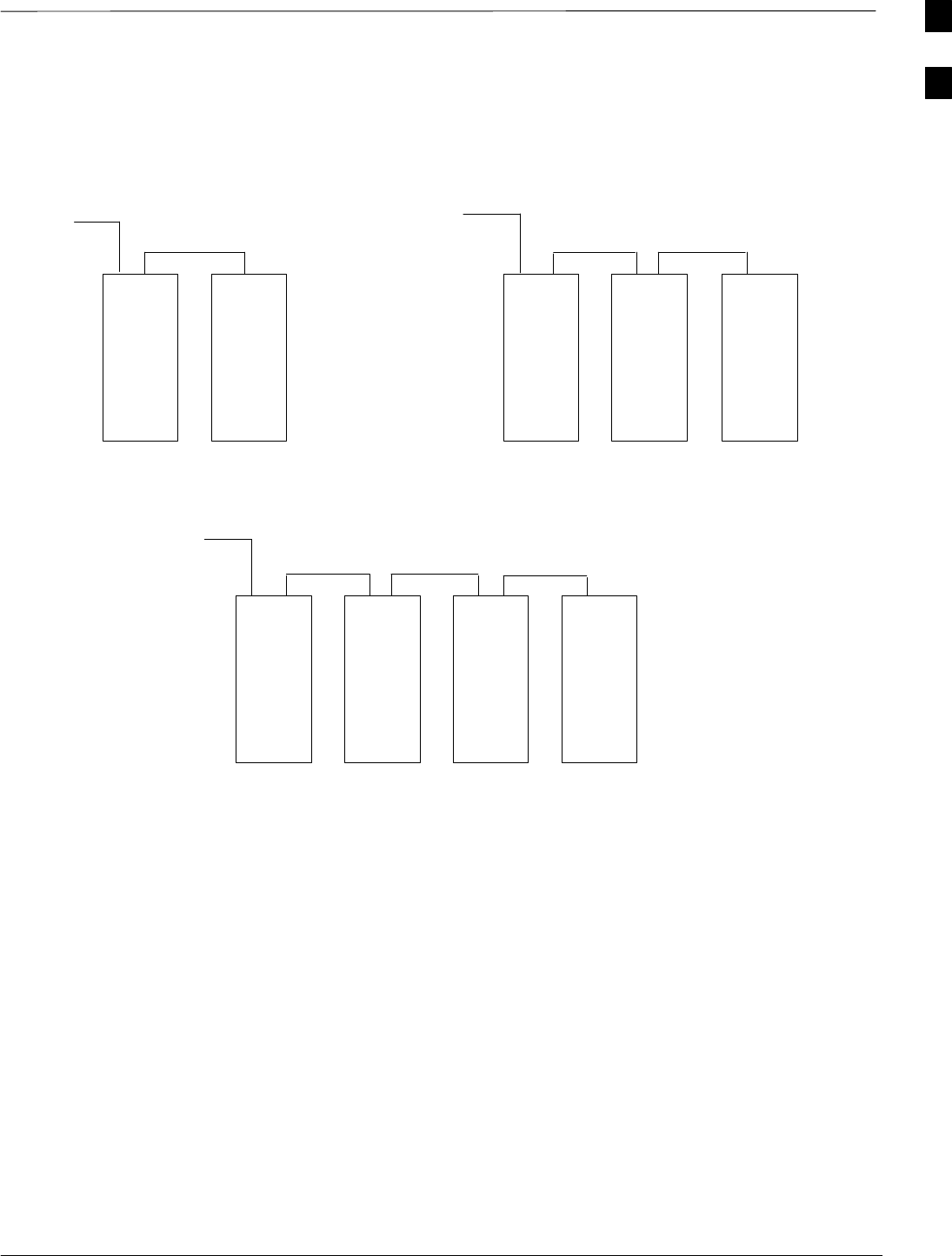
BTS Equipment Identification – continued
Apr 2001 1-15
SCt4812ET BTS Optimization/ATP — CDMA LMF
DRAFT
Figure 1-2: Typical Logical BTS Configurations
BTSSPAN 110
Two Frame Configuration Three Frame Configuration
Frame
1Frame
101 Frame
201
BTSSPAN 110 BTSSPAN 211
Four Frame Configuration
Frame
1Frame
101 Frame
201
BTSSPAN 110 BTSSPAN 211
Frame
301
BTSSPAN 310
Frame
1Frame
101
BTSSPAN
1
BTSSPAN
1
BTSSPAN
1
FW00485REF
AB AAA A
BB
BBBAA
AA
1
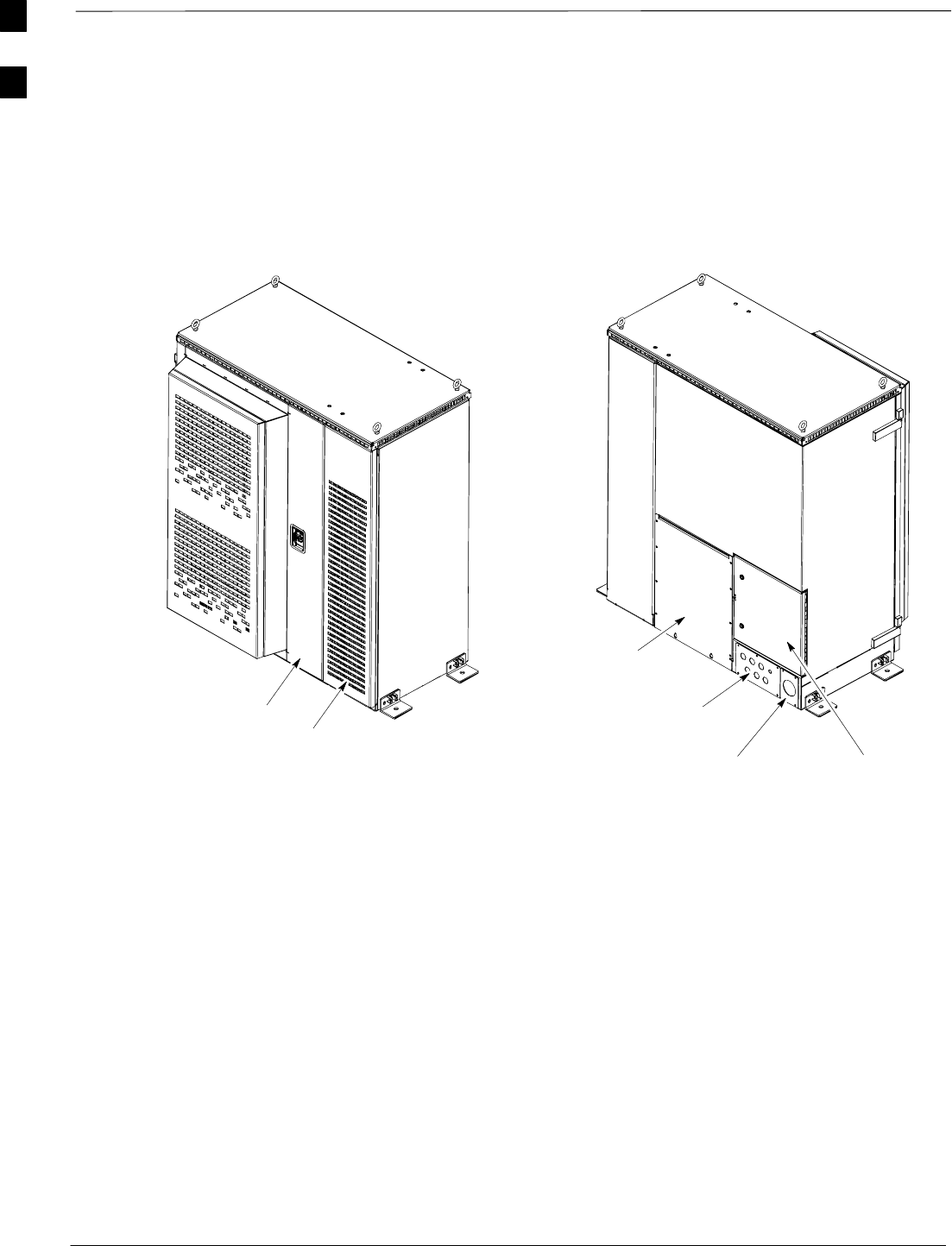
BTS Equipment Identification – continued
DRAFT
SCt4812ET BTS Optimization/ATP — CDMA LMF Apr 2001
1-16
Major Components
The major components that make up the Motorola SC 4812ET are
illustrated in this section: the RF Cabinet (see Figure 1-3) and the Power
Cabinet (see Figure 1-10).
Figure 1-3: SC 4812ET RF Cabinet
Main Door
LPA Door
(Can only be opened after Main Door is open)
RF I/O
Area Cover Plate
Rear I/O DoorRear DC Conduit Panel
Rear Conduit Panel
FW00189
1
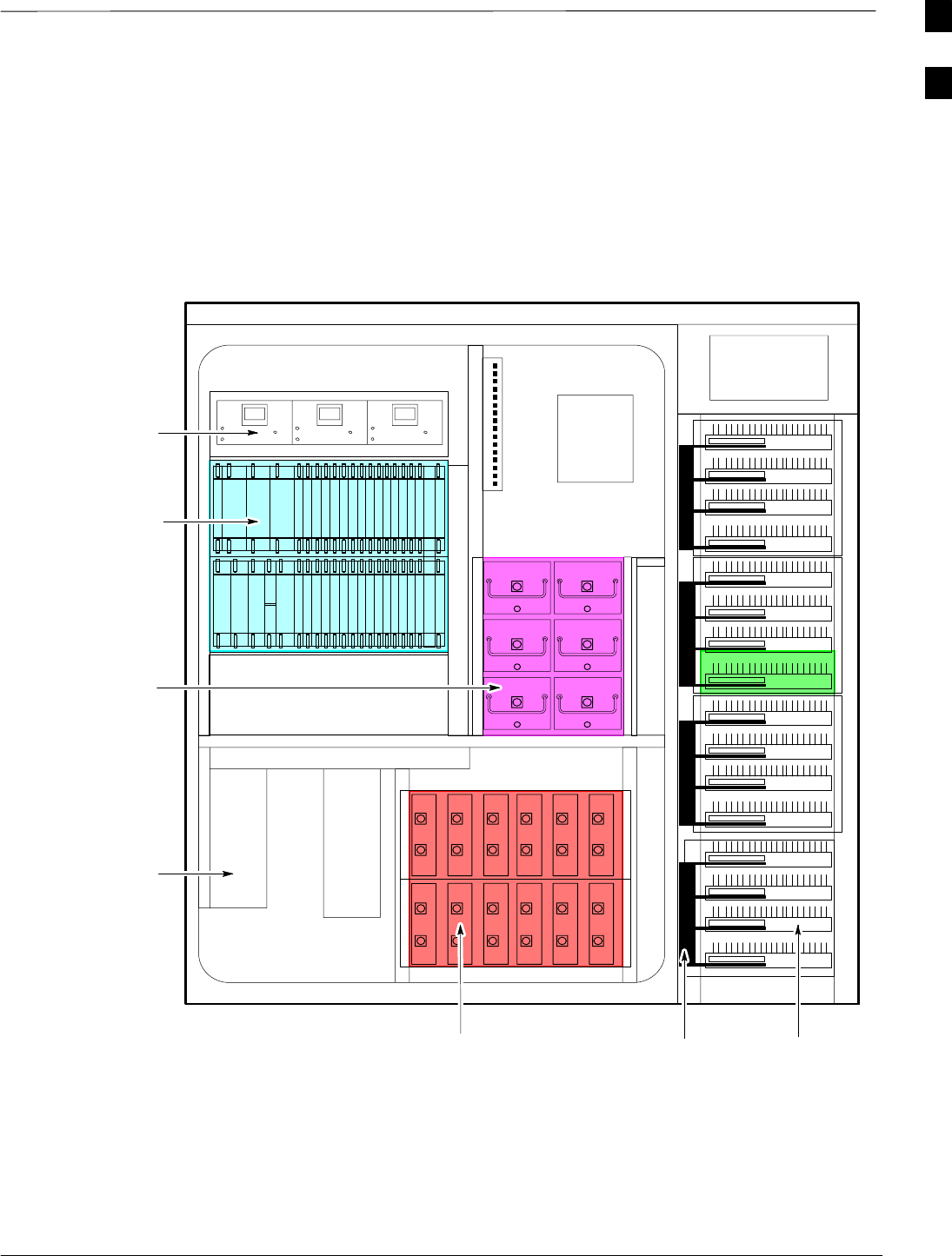
BTS Equipment Identification – continued
Apr 2001 1-17
SCt4812ET BTS Optimization/ATP — CDMA LMF
DRAFT
RF Cabinet Internal
FRUs
Figure 1-4 shows the location of the Internal Field Replaceable
Units (FRUs). A brief description of each Internal FRU is found in the
following paragraphs.
Figure 1-4: RF Cabinet Internal FRUs
DRDC LPA’s
CCP Fans
LPA Trunking
Backplane
5 RU Rack Space
RFDS
DC
Power
Dist.
Punch
Block
(back)
EBA
C–CCP Shelf
Combiner
Cage
Circuit
Breaker Panel
ETIB
FW00163
OPTIONAL AREA
Duplexer/Directional Coupler
The DRDC combines, in a single module, the functions of antenna
duplexing, receive band pass filtering, and surge protection
(see.Figure 1-8).
1

BTS Equipment Identification – continued
DRAFT
SCt4812ET BTS Optimization/ATP — CDMA LMF Apr 2001
1-18
Combiner Cage (2:1, 4:1, or Band pass Filter)
The Combiner Cage holds the transmit band pass filters, 2:1 combiners,
or 4:1 combiners, depending on system configuration.
Combined CDMA Channel Processor Shelf
The C–CCP shelf contains the following (see Figure 1-5):
SHigh Stability Oscillator (HSO) or Low Frequency Receiver (LFR)
card (1)
SClock Synchronization Manager (CSM)card (2 – one with GPS
receiver)
SCDMA Clock Distribution (CCD) cards (2)
SPower Supply cards (2 minimum, 3 maximum)
SMulticoupler Preselector Cards (MPC) or Expansion Multicoupler
Preselector Cards (EMPC) (2)
SAlarm Monitoring and Reporting (AMR) cards (2)
SMulti Channel CDMA (MCC8E, MCC24s or MCC–1Xs) cards (up to
12)
SBroadband Transceiver (BBX2s or BBX–1Xs) cards (up to 13)
SCombined Input/Output (CIO) card (1)
SGroup Line Interface (GLI2) cards (2)
SBBX2 Switch card (1)
SModem (optional)
SFiller Panels (as required)
SFan Module (3)
1

BTS Equipment Identification – continued
Apr 2001 1-19
SCt4812ET BTS Optimization/ATP — CDMA LMF
DRAFT
5 RU RACK
SPACE
RFDS
EBA
ETIB
NOTE: MCCs may be
MCC8Es, MCC24s or
MCC–1Xs. BBXs may
be BBX2s or
BBX–1Xs.
19 mm Filter Panel
Power Supply
AMR
CSM
CSM
MODEM
AMR
GLI2GLI2
MCC24–6
BBX2–1
BBX2–2
BBX2–3
BBX2–4
BBX2–5
BBX2–6
BBX2–RSwitch
CIO
BBX2–7
BBX2–8
BBX2–9
BBX2–10
BBX2–11
BBX2–12
MCC24–5
MCC24–4
MCC24–3
MCC24–2
MCC24–1
MCC24–12
MCC24–11
MCC24–10
MCC24–9
MCC24–8
MCC24–7
Power Supply
Power Supply
CCD CCD
REF FW00304
SC 4812ET RF Cabinet
Figure 1-5: SC 4812ET C–CCP Shelf
HSO/LFR
MPC/EMPC–1MPC/EMPC–2
Punch Block
The Punch Block is the interface point of the RF Cabinet between the
T1/E1 span lines, the Customer I/O, alarms, multi–cabinet timing
(RGPS and RHSO), and Pilot Beacon control (optional). (see
Figure 1-7).
Span I/O Board
The Span I/O Board provides the interface for the span lines from the
CSU to the C–CCP backplane (see Figure 1-7).
RF Diagnostic Subsystem
The RFDS provides the capability for remotely monitoring the status of
the SC 4812ET RF Transmit and Receive paths (Figure 1-8).
Heat Exchanger
The Heat Exchanger provides cooling to the internal compartment of the
RF Cabinet. The fan speed of the heat exchangers adjusts automatically
with temperature. The Heat Exchanger is located in the primary front
door of the RF Cabinet.
SC 4812ET Interface Board (ETIB) & LPA Control Brd (LPAC)
The ETIB is an interconnect board showing status LEDs for the RF
Cabinet, as well as providing secondary surge protection. The LPAC
board provides the interface for the LPA connection.
1
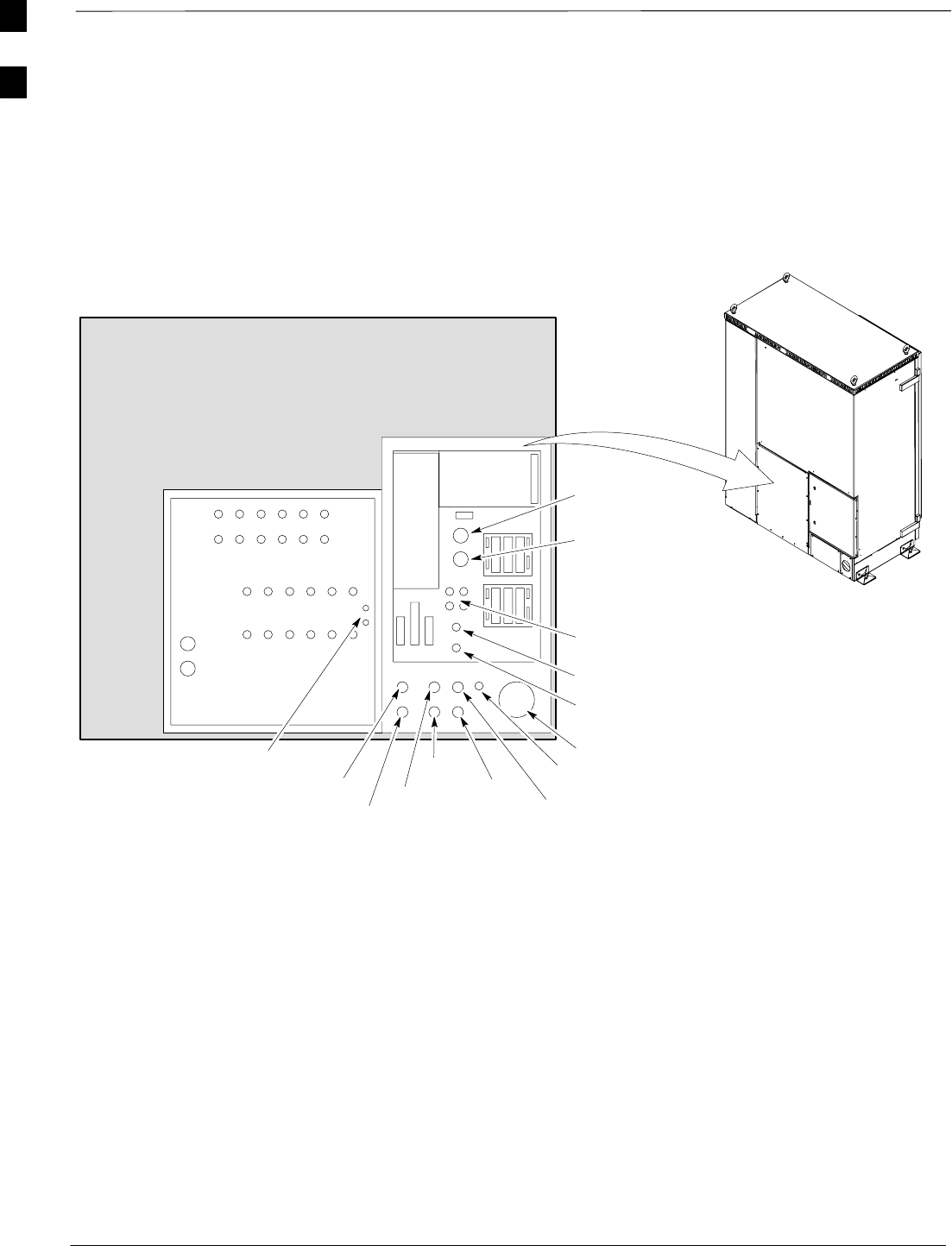
BTS Equipment Identification – continued
DRAFT
SCt4812ET BTS Optimization/ATP — CDMA LMF Apr 2001
1-20
SC 4812ET Trunking Backplane
The Trunking Backplane contains a complex passive RF network that
allows RF signals to share the resources of a bank of four LPAs. It also
provides DC Power and digital interconnect.
SPAN I/O
RFGPS
RF CABINET
(Rear View)
RFDS Expansion
RF Expansion
Exp. Punch
Punch
Block
Block
27V
27V Ret
DC Conduit
Pilot Beacon
Microwave
RF GPS
LAN
2 Sec Tick
19 MHz Clock
Ground Cable
Lugs
1–3 Sector Antennas
4–6 Sector Antennas
Span/Alarm
Expansion 1
Expansion 2
RF CABINET
(Rear Door closed)
RGPS
FW00147
Figure 1-6: SC 4812ET Intercabinet I/O Detail (Rear View)
1
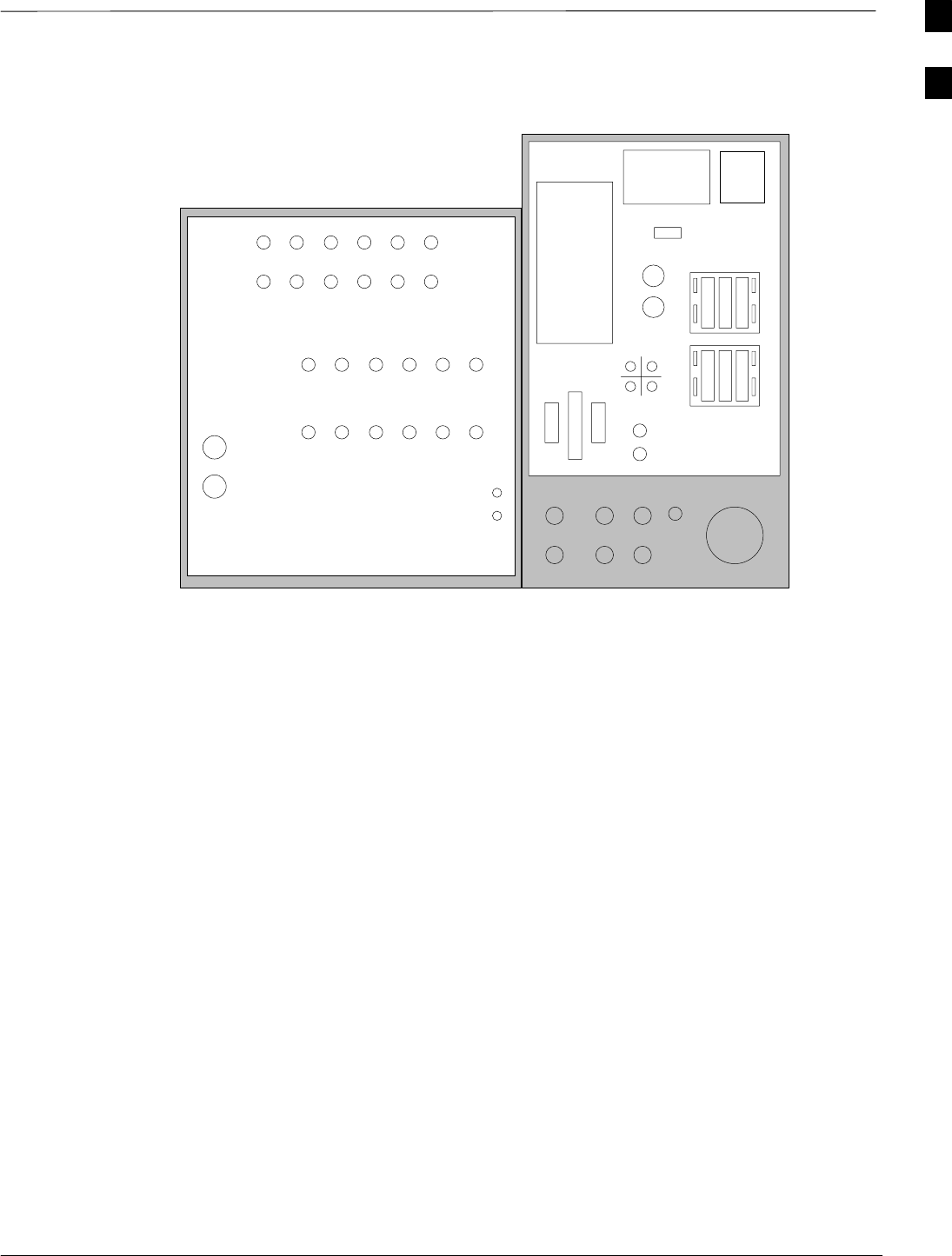
BTS Equipment Identification – continued
Apr 2001 1-21
SCt4812ET BTS Optimization/ATP — CDMA LMF
DRAFT
FW00171
Figure 1-7: SC 4812ET I/O Plate Diagram
RF Expansion Ports
Punch
Block Power Input
27V Ret
Antenna’s
1A 2A 3A 1B 2B 3B
4A 5A 6A 4B 5B 6B
1A 2A 3A 1B 2B 3B
4A 5A 6A 4B 5B 6B
1
2
Remote
ASU
GND
Lugs
50 Pair
(Alarms/Spans)
Punchblock
20 Pair
(RGPS)
RGD
Board
RGD/RGPS
Power Input
+27V
Micro–
wave
RF
GPS
A
B
IN OUT
LAN
19 MHz
2 Sec
Spans
Alams
Modem
1
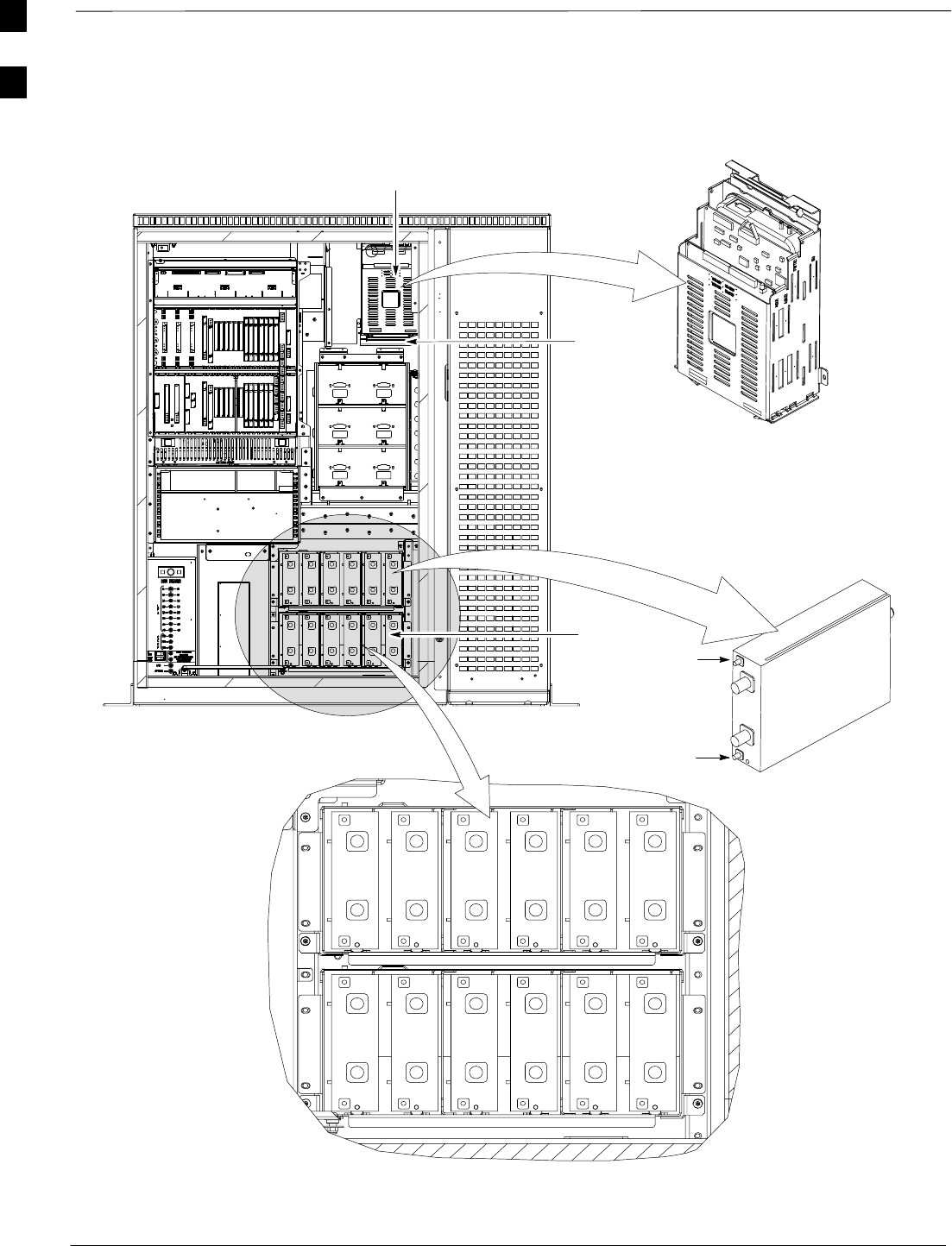
BTS Equipment Identification – continued
DRAFT
SCt4812ET BTS Optimization/ATP — CDMA LMF Apr 2001
1-22
RFDS
FRONT VIEW
(door not shown for clarity)
DRDC CAGE
Figure 1-8: RFDS Location in an SC 4812ET RF Cabinet
DRDC
BTS
CPLD
ANT
CPLD
WALL
MOUNTING
BRACKET
1A2A3A
4A5A6A
1B2B3B
4B5B6B
FW00170
1
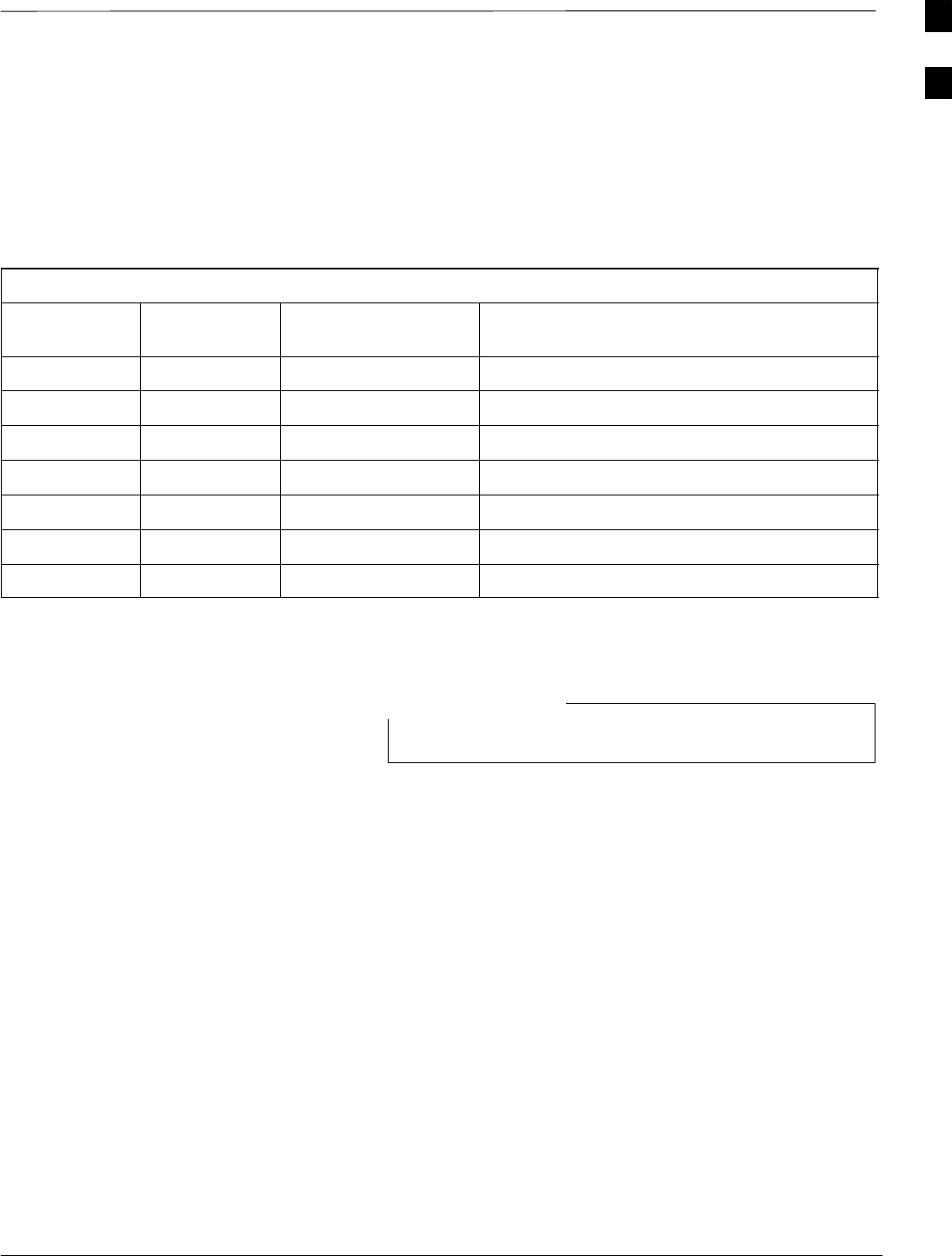
BTS Equipment Identification – continued
Apr 2001 1-23
SCt4812ET BTS Optimization/ATP — CDMA LMF
DRAFT
Sector Configuration
There are a number of ways to configure the BTS frame. Table 1-5
outlines the basic requirements. When carrier capacity is greater than
two, a 2:1 or 4:1 cavity combiner must be used. For one or two carriers,
bandpass filters or cavity combiners may be used, depending on
sectorization and channel sequencing.
Table 1-5: BTS Sector Configuration
Number of
carriers Number of
sectors Channel spacing Filter requirements
13 or 6 N/A Bandpass Filter, Cavity Combiner (2:1 or 4:1)
2 6 Non–adjacent Cavity Combiner (2:1 Only)
2 6 Adjacent Dual Band Pass Filter
2 3 Non–adjacent Cavity Combiner (2:1 or 4:1)
2 3 Adjacent Bandpass Filter
3,4 3 Non–adjacent Cavity Combiner (2:1 or 4:1)
3,4 3 Adjacent Cavity Combiner (2:1 Only)
The matrix in Table 1-6 shows a correlation between the various sector
configurations and BBX cards.
In Table 1-6, BBXs may be BBX2s or BBX–1Xs.
NOTE
1
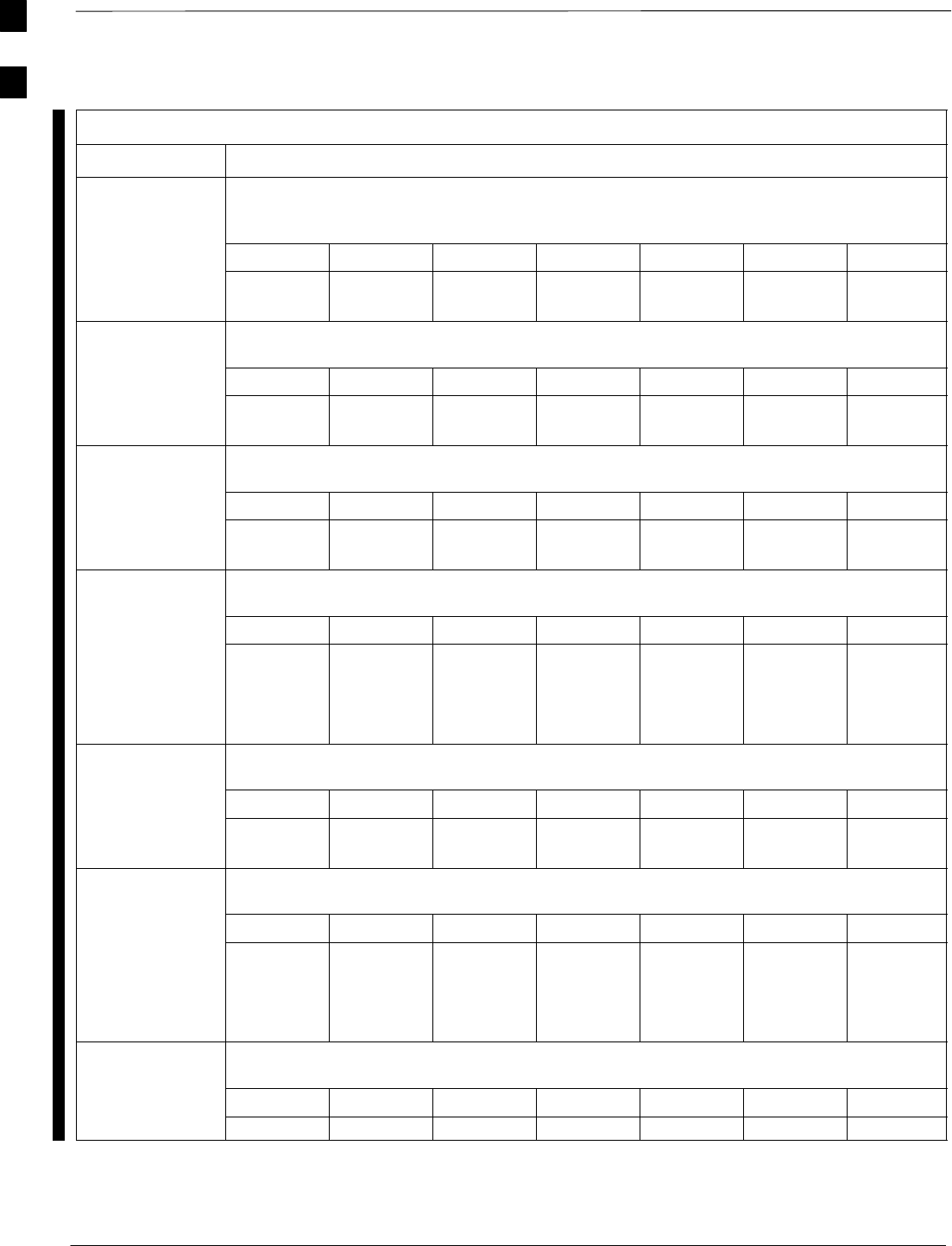
BTS Equipment Identification – continued
DRAFT
SCt4812ET BTS Optimization/ATP — CDMA LMF Apr 2001
1-24
Table 1-6: Sector Configurations
Config Ref. No. Description
3–Sector/2–ADJACENT Carriers – The configuration below maps TX with optional 2:1 cavity
combiners for 3 sectors/2 carriers for adjacent channels. Note that 2:1 cavity combiners are used (6
total).
1TX1 TX2 TX3 TX4 TX5 TX6 Carrier#
BBX–1 BBX–2 BBX–3 N/A N/A N/A 1
N/A N/A N/A BBX–4 BBX–5 BBX–6 2
6–Sector/2–NON–ADJACENT Carriers – The configuration below maps TX with 2:1 cavity
combiners for 6 sectors/2 carriers for non–adjacent channels.
2TX1 TX2 TX3 TX4 TX5 TX6 Carrier#
BBX–1 BBX–2 BBX–3 BBX–4 BBX–5 BBX–6 1
BBX–7 BBX–8 BBX–9 BBX–10 BBX–11 BBX–12 2
3–Sector/2–NON–ADJACENT Carriers – The configuration below maps TX with 2:1 cavity
combiners for 3 sectors/2 carriers for non–adjacent channels.
3TX1 TX2 TX3 TX4 TX5 TX6 Carrier#
BBX–1 BBX–2 BBX–3 N/A N/A N/A 1
BBX–7 BBX–8 BBX–9 N/A N/A N/A 2
3–Sector/4–ADJACENT Carriers – The configuration below maps TX with 2:1 cavity combiners
for 3 sector/4 carriers for adjacent channels.
TX1 TX2 TX3 TX4 TX5 TX6 Carrier#
4BBX–1 BBX–2 BBX–3 N/A N/A N/A 1
BBX–7 BBX–8 BBX–9 N/A N/A N/A 2
N/A N/A N/A BBX–4 BBX–5 BBX–6 3
N/A N/A N/A BBX–10 BBX–11 BBX–12 4
3–Sector / 2–ADJACENT Carriers – The configuration below maps TX with bandpass filters for
3 sectors/2 carriers for adjacent channels.
5TX1 TX2 TX3 TX4 TX5 TX6 Carrier#
BBX–1 BBX–2 BBX–3 N/A N/A N/A 1
N/A N/A N/A BBX–7 BBX–8 BBX–9 2
3–Sector/3 or 4–NON–ADJACENT Carriers – The configuration below maps TX with 4:1
cavity combiners for 3 sectors/3 or 4 carriers for non–adjacent channels.
TX1 TX2 TX3 TX4 TX5 TX6 Carrier#
6BBX–1 BBX–2 BBX–3 N/A N/A N/A 1
BBX–7 BBX–8 BBX–9 N/A N/A N/A 2
BBX–4 BBX–5 BBX–6 N/A N/A N/A 3
BBX–10 BBX–11 BBX–12 N/A N/A N/A 4
6–Sector/1–Carrier – The configuration below maps TX with either bandpass filters or 2:1 cavity
combiners for 6 sector/1 carrier.
7TX1 TX2 TX3 TX4 TX5 TX6 Carrier#
BBX–1 BBX–2 BBX–3 BBX–4 BBX–5 BBX–6 1
1
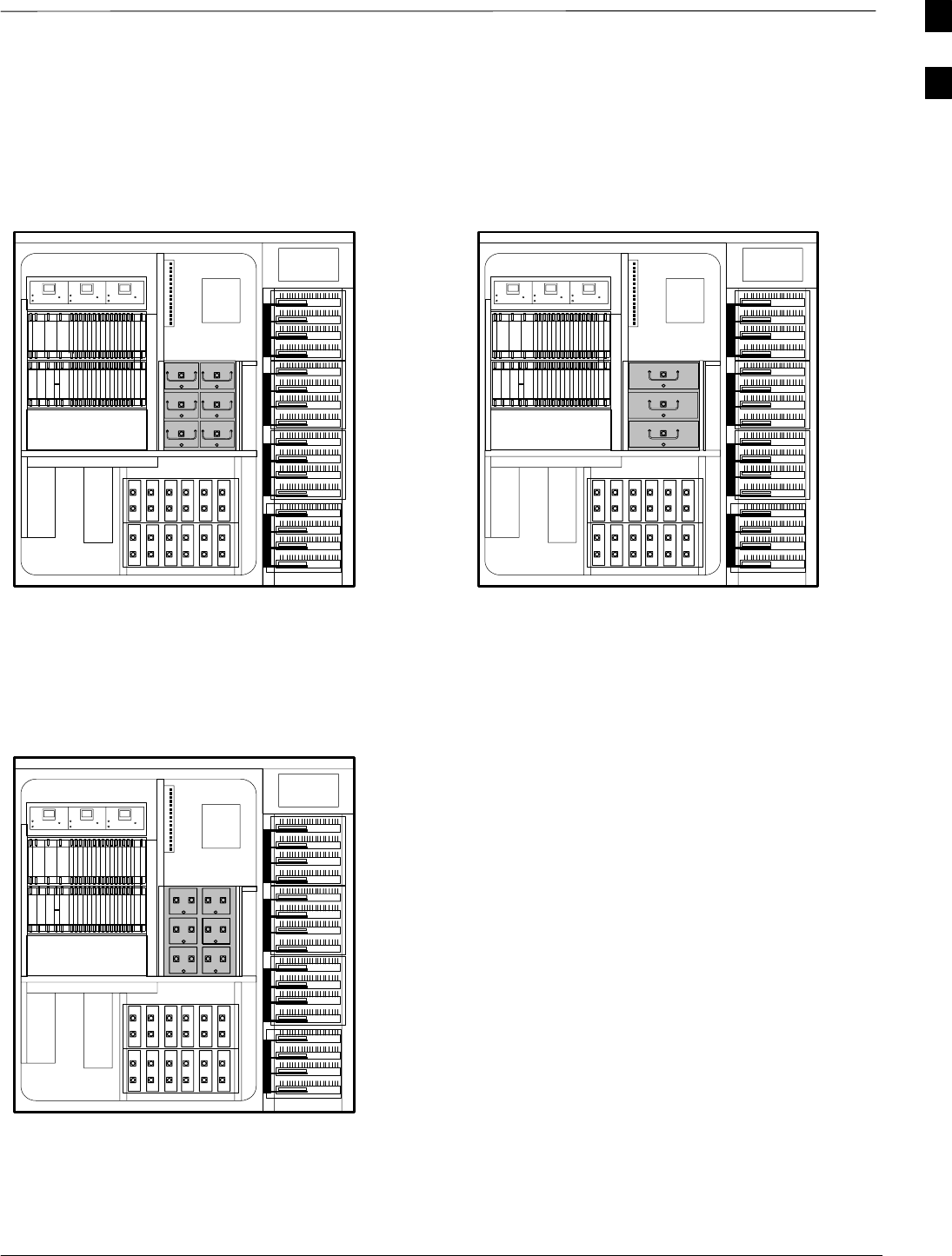
BTS Equipment Identification – continued
Apr 2001 1-25
SCt4812ET BTS Optimization/ATP — CDMA LMF
DRAFT
5 RU RACK
SPACE
RFDS
EBA
ETIB
5 RU RACK
SPACE
Sector
3 Sector
Numbering
(6 Sector)
4 to 1 Combiner
3 Sector Only
Dual Bandpass Filter
3 Sector Only
2 Carrier Maximum
Figure 1-9: SC4812ET LPA Configuration with Combiners/Filters
RFDS
EBA
ETIB
2 to 1 Combiner
3 Sector or 6 Sector
Sector
3 Sector
Numbering
(6 Sector)
C1, S1–S3
(C1, S1–S3)
C2, S1–S3
(C1, S4–S6)
C3, S1–S3
(C2, S1–S3)
C4, S1–S3
(C2, S4–S6)
C1
C2
C3
C4
C1, S1–S3
(C1, S1–S3)
C2, S1–S3
(C1, S4–S6)
C3, S1–S3
(C2, S1–S3)
C4, S1–S3
(C2, S4–S6)
5 RU RACK
SPACE
RFDS
EBA
ETIB
FW00166
1
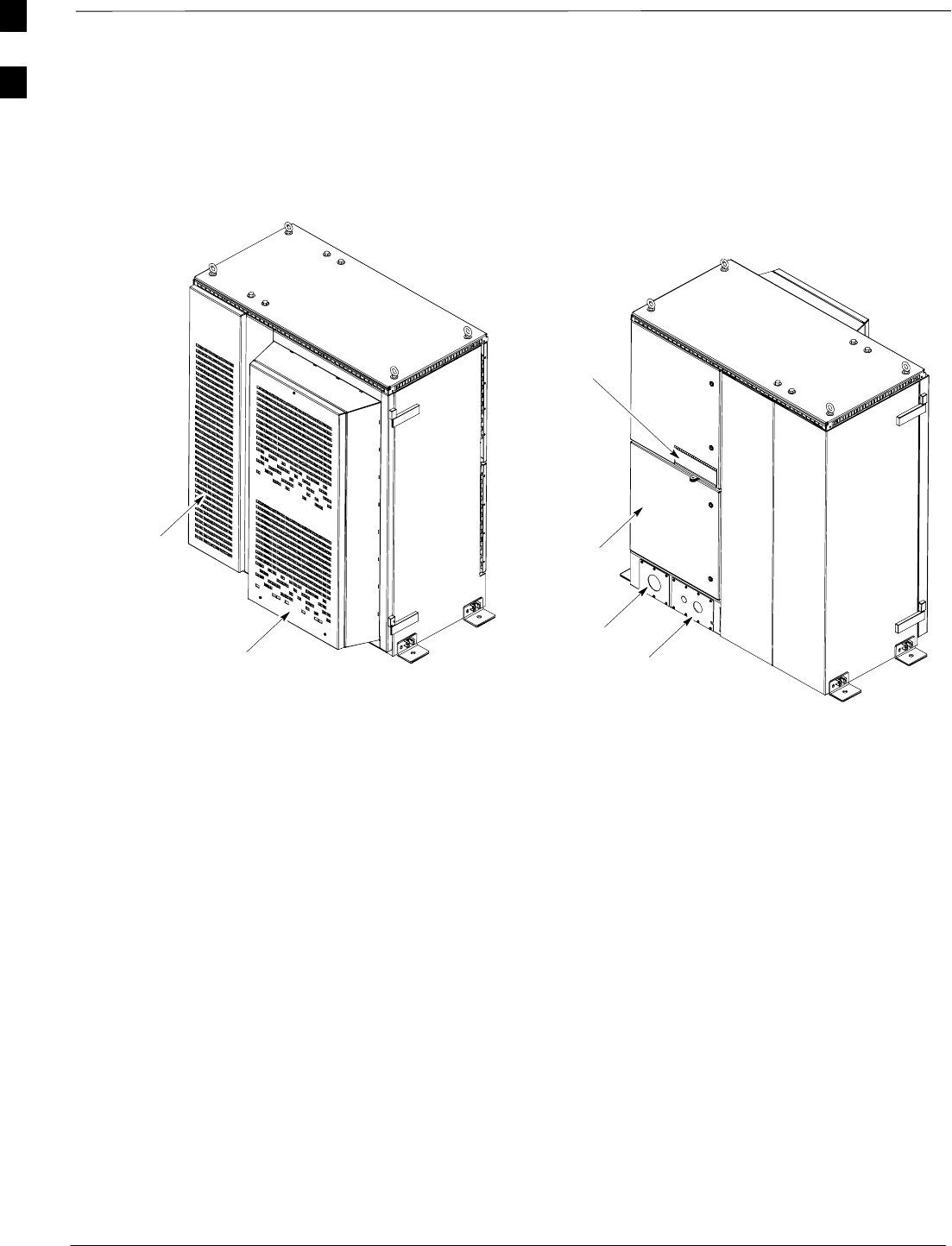
BTS Equipment Identification – continued
DRAFT
SCt4812ET BTS Optimization/ATP — CDMA LMF Apr 2001
1-26
Power Cabinet
Figure 1-10 illustrates the Power Cabinet design.
Figure 1-10: Power Cabinet
GFCI Outlet
Cover
Rear I/O
Door
Rear AC Conduit
Panel
Battery Door
Main Door
Rear DC
Conduit Panel
FW00193
1
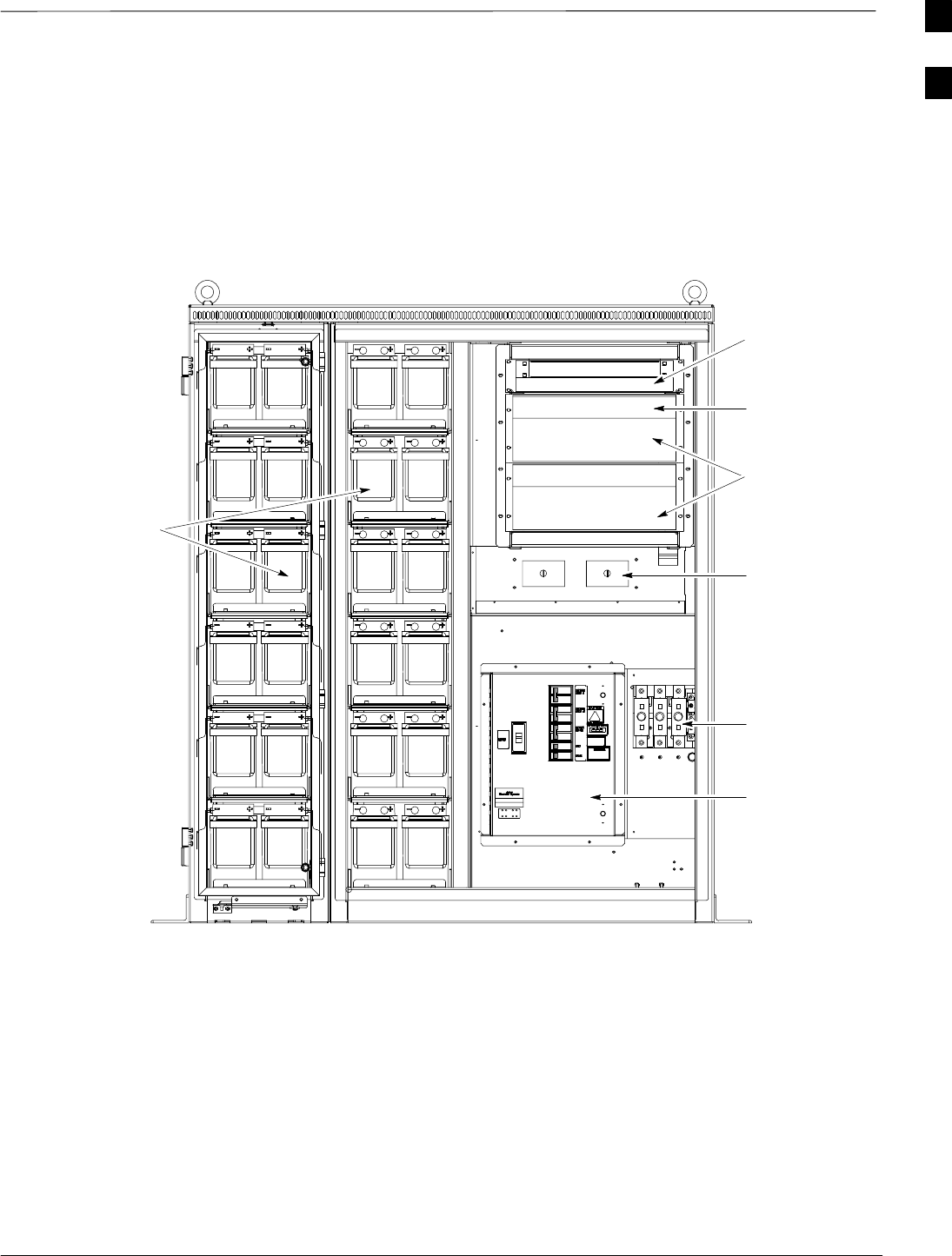
BTS Equipment Identification – continued
Apr 2001 1-27
SCt4812ET BTS Optimization/ATP — CDMA LMF
DRAFT
Power Cabinet Internal
FRUs
Figure 1-11 shows the location of the Internal Field Replaceable
Units (FRUs). A brief description of each Internal FRU is found in the
following paragraphs.
Figure 1-11: Power Cabinet with Batteries Installed (Doors Removed for Clarity)
NOTE
Punch Block is not
visible in this view.
Rectifier
Shelves
Rectifier
Alarm Module
DC Circuit
Breakers
AC Load
Center
GFCI Outlets
(Back)
Temperature
Control Module
FRONT VIEW POWER CABINET
Batteries (Battery
Heaters located
under batteries)
FW00164
Batteries
The batteries provide a +24 Vdc backup to the RF Cabinet should AC
Power be lost. The Power Cabinet can accommodate a total of 24 12–V
batteries, configured in 12 strings of 2 batteries each. The time duration
of backup provided depends on system configuration.
Battery Heater
The battery heaters provide heating to the batteries in the Power Cabinet.
A separate heater is required for each string of batteries. The heater is a
pad the batteries sit on located top of each battery shelf. The number of
heaters is dependent on system configuration.
1

BTS Equipment Identification – continued
DRAFT
SCt4812ET BTS Optimization/ATP — CDMA LMF Apr 2001
1-28
Battery Compartment Fan
The battery compartment fan provides air circulation for the two battery
compartments. It is located on the inside of the battery compartment
door.
Heat Exchanger
The Heat Exchanger provides cooling to the rectifier compartment of the
Power Cabinet. The Heat Exchanger is located in the primary front door
of the Power Cabinet.
Rectifiers
The +27 Vdc rectifiers convert the AC power supplied to the Power
Cabinet to +27 Vdc to power the RF Cabinet and maintain the charge of
the batteries.
AC Load Center
The ACLC is the point of entry for AC Power to the Power Cabinet. It
incorporates AC power distribution and surge protection.
Punch Block
The Punch Block is the interface for the alarm signalling between the
Power Cabinet and the RF Cabinet.
1

Apr 2001 SCt4812ET BTS Optimization/ATP — CDMA LMF
DRAFT
Chapter 2: Preliminary Operations
Table of Contents
Preliminary Operations: Overview 2-1. . . . . . . . . . . . . . . . . . . . . . . . . . . . . . . . . . .
Introduction 2-1. . . . . . . . . . . . . . . . . . . . . . . . . . . . . . . . . . . . . . . . . . . . . .
Cellsite Types 2-1. . . . . . . . . . . . . . . . . . . . . . . . . . . . . . . . . . . . . . . . . . . . .
CDF 2-1. . . . . . . . . . . . . . . . . . . . . . . . . . . . . . . . . . . . . . . . . . . . . . . . . . . .
Site Equipage Verification 2-1. . . . . . . . . . . . . . . . . . . . . . . . . . . . . . . . . . .
Initial Installation of Boards/Modules 2-1. . . . . . . . . . . . . . . . . . . . . . . . . .
Setting Frame C–CCP Shelf Configuration Switch 2-2. . . . . . . . . . . . . . .
Initial Power Up 2-3. . . . . . . . . . . . . . . . . . . . . . . . . . . . . . . . . . . . . . . . . . . . . . . . .
Introduction 2-3. . . . . . . . . . . . . . . . . . . . . . . . . . . . . . . . . . . . . . . . . . . . . .
Required Tools 2-3. . . . . . . . . . . . . . . . . . . . . . . . . . . . . . . . . . . . . . . . . . . .
Cabling Inspection 2-3. . . . . . . . . . . . . . . . . . . . . . . . . . . . . . . . . . . . . . . . .
Initial Inspection and Setup 2-3. . . . . . . . . . . . . . . . . . . . . . . . . . . . . . . . . .
Power Up Sequence 2-4. . . . . . . . . . . . . . . . . . . . . . . . . . . . . . . . . . . . . . . .
Applying AC Power 2-5. . . . . . . . . . . . . . . . . . . . . . . . . . . . . . . . . . . . . . .
Power Cabinet Power Up Tests 2-6. . . . . . . . . . . . . . . . . . . . . . . . . . . . . . .
DC Power Pre-test (BTS Frame) 2-7. . . . . . . . . . . . . . . . . . . . . . . . . . . . . .
RF Cabinet Power Up 2-8. . . . . . . . . . . . . . . . . . . . . . . . . . . . . . . . . . . . . .
Battery Charge Test (Connected Batteries) 2-10. . . . . . . . . . . . . . . . . . . . . .
Battery Discharge Test 2-10. . . . . . . . . . . . . . . . . . . . . . . . . . . . . . . . . . . . . .
Heat Exchanger Power Up 2-11. . . . . . . . . . . . . . . . . . . . . . . . . . . . . . . . . . .
2

Table of Contents – continued
DRAFT
SCt4812ET BTS Optimization/ATP — CDMA LMF Apr 2001
Notes
2
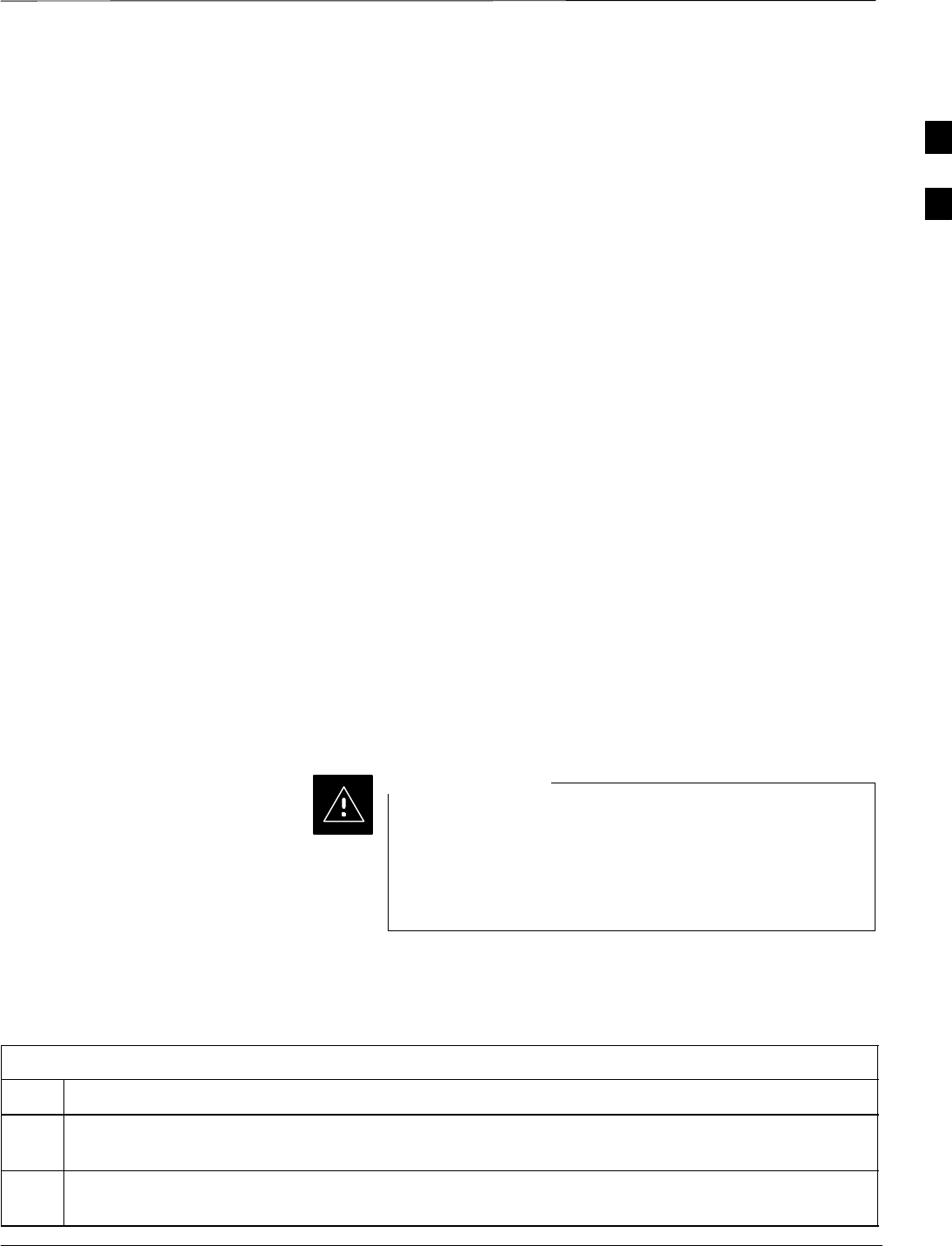
Preliminary Operations: Overview
Apr 2001 2-1
SCt4812ET BTS Optimization/ATP — CDMA LMF
DRAFT
Introduction
This section first verifies proper frame equipage. This includes verifying
module placement, jumper, and dual in–line package (DIP) switch
settings against the site-specific documentation supplied for each BTS
application. Next, pre-power up and initial power-up procedures are
presented.
Cellsite Types
Sites are configured as with a maximum of 4 carriers, 3–sectored with a
maximum of 4 carriers, and 6–sectored with a maximum of 2 carriers.
Each type has unique characteristics and must be optimized accordingly.
CDF
The Cell-site Data File (CDF) contains site type and equipage data
information and passes it directly to the LMF during optimization. The
number of modem frames, C–CCP shelves, BBX2 and
MCC24E/MCC8E boards (per cage), and linear power amplifier
assignments are some of the equipage data included in the CDF.
Site Equipage Verification
Review the site documentation. Match the site engineering equipage data
to the actual boards and modules shipped to the site. Physically inspect
and verify the equipment provided for the BTS or Modem frame and
ancillary equipment frame.
Always wear a conductive, high impedance wrist strap
while handling any circuit card/module to prevent damage
by ESD. After removal, the card/module should be placed
on a conductive surface or back into the anti–static bag it
was shipped in.
CAUTION
Initial Installation of
Boards/Modules
Table 2-1: Initial Installation of Boards/Modules
Step Action
1Refer to the site documentation and install all boards and modules into the appropriate shelves as
required. Verify they are NOT SEATED at this time.
2As the actual site hardware is installed, record the serial number of each module on a “Serial Number
Checklist” in the site logbook.
2
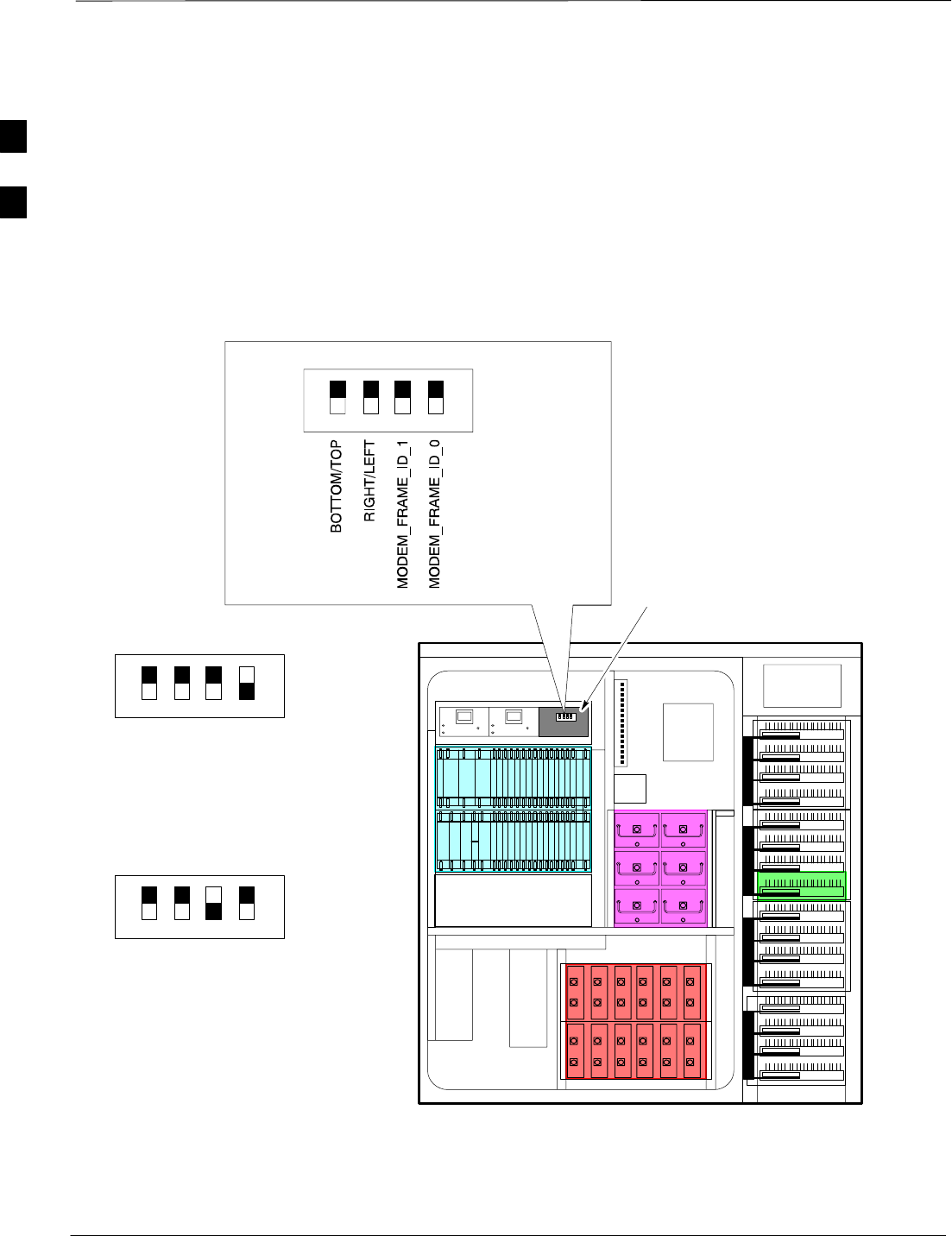
Preliminary Operations: Overview – continued
DRAFT
SCt4812ET BTS Optimization/ATP — CDMA LMF Apr 2001
2-2
Setting Frame C–CCP Shelf
Configuration Switch
If the frame is a Starter BTS, the backplane switch settings behind the
fan module should be set to the ON position (see Figure 2-1).
The switch setting must be verified and set before power is applied to the
BTS equipment.
SC 4812ET
C–CCP SHELF
FAN MODULE
REMOVED
5 RU RACK SPACE
RFDS
EBA
ETIB
ON
OFF STARTER FRAME
Figure 2-1: Backplane DIP Switch Settings
FW00167
ON
OFF
EXPANSION
FRAME 1
SETTING
ON
OFF
EXPANSION
FRAME 2
SETTING
BOTTOM / TOP
RIGHT / LEFT
MODEM_FRAME_ID_1
MODEM_FRAME_ID_0
BOTTOM / TOP
RIGHT / LEFT
MODEM_FRAME_ID_1
MODEM_FRAME_ID_0
2